|
Only Since World War II has the term
Southeast Asia been used to describe the area to the east of India and to the
south of China, which includes the Indo-Chinese Peninsula, the Malay Archipelago
and the Philippines, roughly forming a circle from Burma through Indonesia to
Vietnam. Before the term Southeast Asia became common usage, the region was
often described as Further or Greater India, and it was common to describe the
Indonesian region or Malay Archipelago as the East Indies. The reason may be
found in the fact that, prior to Western dominance, Southeast Asia was closely
allied to India culturally and commercially. The history of Indian expansion
covers a period of more than fifteen hundred years.
This region was broadly referred to by
ancient Indians as Suvarnabhumi (the Land of Gold) or Suvarnadvipa (the Island
of Gold), although scholars dispute its exact definition. Sometimes the term is
interpreted to mean only Indonesia or Sumatra. Arab writers such as Al Biruni
testify that Indians called the whole Southeast region Suwarndib (Suvarnadvipa).
Hellenistic geographers knew the area as the Golden Ghersonese. The Chinese
called it Kin-Lin; Kin means gold. During the last two thousand years, this
region has come under the influence of practically all the major civilizations
of the world: Indian, Chinese, Islamic, and Western. Of these, Indian culture
appears to have blended best with the indigenous culture.
The name Java comes from the Sanskrit Jawadwip, which means a (dvip)
island (yawa) shaped like a barley corn. The Vedic Indians must have charted
Java, Yawadvip, thousands of years ago because Yawadvip is mentioned in India's
earliest epic, the Ramayana. The Ramayana reveals some knowledge
of the eastern regions beyond seas; for instance Sugriva dispatched his men to
Yavadvipa, the island of Java, in search of Sita. It speaks of Burma
as the land of silver mines. The Agni Purana, along with many other Puranas,
calls India
proper as Jambudvipa as distinguished from Dvipantara or India of the islands or
overseas India. Towards the end of
the fifth century, Aryabhatta, the Indian astronomer, wrote that when the sun
rose in Ceylon it was midday in Yavakoti (Java) and midnight in the Roman land.
In the Surya Siddhanta reference is also made to the Nagari Yavakoti with golden
walls and gates.
Seldom has the world seen such a protracted and pervasive
cultural diffusion. It stands a monument to the vitality and magnetism of Indian
civilization.
     
Suvarnabhumi: Asianization of Indian Culture
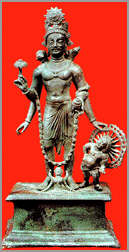 India has always given a
great deal more than she has received. Civilization as we know today would not
exist without India. India has always given a
great deal more than she has received. Civilization as we know today would not
exist without India.
Indianization
of Asia was entirely peaceful, never resorting to physical force or coercion to
subvert local cultures or identities, or to engage in economic or political
exploitation of the host cultures and societies. Its worldviews were based on
compassion and mutual exchange, and not on the principle of conquest and
domination.
"The
unique feature of India's contacts and relationship with other countries and
peoples of the world is that the cultural expansion was never confused with
colonial domination and commercial dynamism far less economic exploitation.
That culture can advance without political motives, that trade can proceed
without imperialist designs, settlements can take place without colonial
excesses and that literature, religion and language can be transported without
xenophobia, jingoism and race complexes are amply evidenced from the history of
India's contact with her neighbors...Thus although a considerable part of
central and south-eastern Asia became flourishing centers of Indian culture,
they were seldom subjects to the regime of any Indian king or conquerors and
hardly witnessed the horrors and havocs of any Indian military campaign. They
were perfectly free, politically and economically and their people representing
an integration of Indian and indigenous elements had no links with any Indian
state and looked upon India as a holy land rather than a motherland – a land
of pilgrimage and not an area of jurisdiction."
(source:
Greater
India - By Arun Bhattacharjee -
Munshiram Manoharlal Publishers Private Limited, 1981, New Delhi p. 2
- 3 and Indian
Culture over the World - By S V Shevade p.
91 and The
Soul of India - By Satyavrata R Patel p. 30 and Geopolitics
and Sanskrit phobia
-
By Rajiv Malhotra -
sulekha.com).
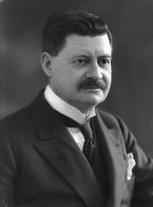 Sir Charles
Norton Edgcumbe Eliot
(1862-1931) British diplomat and colonial administrator, in his book, Hinduism and Buddhism,
vol. I, p.12. says: Sir Charles
Norton Edgcumbe Eliot
(1862-1931) British diplomat and colonial administrator, in his book, Hinduism and Buddhism,
vol. I, p.12. says:
"In
Eastern Asia the influence of India has been notable in extent, strength, and
duration."
"Scant justice is done to India's position
in the world by those European histories which recount the exploits of her
invaders and leave the impression that her own people were a feeble dreamy folk,
surrendered from the rest of mankind by their seas and mountain frontiers. Such
a picture takes no account of the intellectual conquests of the Hindus."
Even their political conquests were not contemptible, and are remarkable for
the distance, if not the extent, of the territories occupied...But
such military or commercial invasions are insignificant compared with the spread
of Indian thought." The south-eastern region of Asia
both mainland and Archipelago - owed its civilization almost entirely to India.
In Ceylon, Burma, Siam, Cambodia, Champa, and Java, religion, art, the alphabet,
literature, as well as whatever science and political organization existed, were
the direct gift of Hindus, whether Brahmin or Buddhists, and much the same may
be said of Tibet, whence the wilder Mongols took as much Indian civilization as
they could stomach."
(source: Eminent
Orientalists: Indian European American - Asian Educational
Services. p. 369).
 French
scholar, Sylvain
Levi (1863-1935) Orientalist who wrote on Eastern religion,
literature, and history. Levi
was appointed a lecturer at the school of higher studies
in Paris (1886), he taught Sanskrit at the Sorbonne (1889-94) and wrote his
doctoral dissertation, Le Théâtre indien ("The Indian
Theatre"). In L'Inde
et le monde ("India and the World"), he discussed India's role
among nations. He
writes: French
scholar, Sylvain
Levi (1863-1935) Orientalist who wrote on Eastern religion,
literature, and history. Levi
was appointed a lecturer at the school of higher studies
in Paris (1886), he taught Sanskrit at the Sorbonne (1889-94) and wrote his
doctoral dissertation, Le Théâtre indien ("The Indian
Theatre"). In L'Inde
et le monde ("India and the World"), he discussed India's role
among nations. He
writes:
"From Persia to the Chinese Sea,
from the icy regions of Siberia to the islands of Java and Borneo, from Oceania
to Socotra, India has propagated her beliefs, her tales and her civilization.
She has left indelible imprints on one-fourth of the human race in the course of
a long succession of centuries. She has the right to reclaim in universal
history the rank that ignorance has refused her for a long time and to hold her
place amongst the great nations summarizing and symbolizing the spirit of
Humanity."
(source: Discovery of India - By
Jawaharlal
Nehru. p. 200 -210). Refer
to India
once ruled the Americas! – By Gene D Matlock
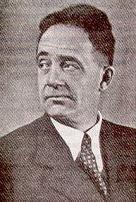 Heinrich
Zimmer (1890-1943) the great German
Indologist, in the noblest of
many books, in his book, Asia before Europe: Economy
and Civilization of the Indian Ocean from the Rise of Islam to 1750,
writes of the Indian cultural world: Heinrich
Zimmer (1890-1943) the great German
Indologist, in the noblest of
many books, in his book, Asia before Europe: Economy
and Civilization of the Indian Ocean from the Rise of Islam to 1750,
writes of the Indian cultural world:
“Each of the colonial cultures and art styles of Ceylon,
Indonesia, and Further India, as well as that of Tibet, China, Korea and Japan,
took over in a worthy way the Indian heritage, giving to it an original and
happy local application. Out of various ethnological and biological requirements
self-contained styles were formed that were the peers in originality, nobility
and delicacy of the Indian.”
India remains “the creative
hearth”: Indeed, whenever the incredible brightness of the spiritual, the
balanced repose of the dynamic, or the brilliant power of the triumphantly
omnipotent are made effectively manifestation in Oriental art, an Indian model
is not far to seek.”
(source: Under Western Eyes
- By Balachandra Rajan p. 37 – 38).

Greater India: The expansion of Indian
culture and influence both in Central Asia and the South East towards the
countries and islands of the Pacific is one of the momentous factors of world
history.
(image source: A Survey of Indian History
- By Sardar
Kavalam Madhava Panikkar).
***
 Wilhelm Von
Humboldt (1767-1835) German Indologist, Prussian minister of education, a brilliant linguist and
the founder of the science of general linguistics. Wilhelm Von
Humboldt (1767-1835) German Indologist, Prussian minister of education, a brilliant linguist and
the founder of the science of general linguistics.
He wrote:
"The Relation between India and
Java"; in it the author discusses the cultural influence India extended on
countries further east. Humboldt showed that the Kawi
language is Javanese and contains a number of Sanskrit loan words which prove
the literary and political superiority of the Hindus.
The historical
background is the emigration of Brahmins, who brought the Mahabharata, the
Ramayana and other works of Sanskrit literature. He showed that no Prakrit words
are found in Old Javanese and he deduced from this that the Indian immigrants
must have come to Java at a time when the more recent Indian languages had not
yet separated from Sanskrit."
(source: German
Indologists: Biographies of Scholars in Indian Studies writing in German
- By Valentine Stache-Rosen. p 5 - 6).
B G Gokhale ( ? ) rightly
observes:
“Looking at the cultures of the peoples of Asia in general and south
east Asia in particular, the awareness grows upon us that what we see in Burma
or Siam or Indonesia is but an extension of Indian culture – they could be
legitimately called a Greater India.”
(source:
Greater
India - By Arun Bhattacharjee -
Munshiram
Manoharlal Publishers Private Limited, 1981, New Delhi p. 1 - 20).
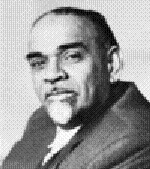 Sardar
Kavalam Madhava Panikkar (1896-1963) Indian historian, in his
book A Survey of Indian History, was the
most impressive in depicting how South India’s expansion into “further
India” was achieved by the very sea power that ten centuries later was to open
India to colonization by the West: Sardar
Kavalam Madhava Panikkar (1896-1963) Indian historian, in his
book A Survey of Indian History, was the
most impressive in depicting how South India’s expansion into “further
India” was achieved by the very sea power that ten centuries later was to open
India to colonization by the West:
"From the first
century A.D we witness the strange fact of Hindu or Hinduised kingdoms in
Annam
, Cochin-China and the islands of the Pacific. The
Ramayana knew of Java and
Sumatra
. Communication by sea between the ports of
South India
and the islands of the Pacific was well established many centuries before the
Christian era."
(source: A Survey of Indian History
- By Sardar
Kavalam Madhava Panikkar p.
68 - 69).
“At the end of the fifth century the area of the Mekong
valley, Malaya and the Indonesian islands were dotted with Hindu principalities
some of which, like the kingdom of Funan, had attained considerable importance
and prosperity. This was the formative period. Hindu culture and organization
had been established on a firm basis, and the local population – at least the
higher strata – assimilated with the Indian emigrants and colonists. The next
five centuries witness a great flowering of Indian culture in these areas which
properly belong to Indian history, because at least till the twelfth century,
these people considered themselves as integrally belonging to the Indian
world.”
"The
early inscriptions are in classical Sanskrit, full of allusions to ancient
India..."Kambuja was ardently Hindu till the middle of the seventh century
when Buddhism is first alluded to. The two religions co-existed as in India,
though till the very end Hinduism continued predominant."
(source: Under Western Eyes - By Balachandra
Rajan p. 37 – 38).
 Suharto
Sukarno (1901- 1970) Indonesian nationalist
leader and the first President of Indonesia. He helped the country win its
independence from the Netherlands. He
echoed the same sentiments. Suharto
Sukarno (1901- 1970) Indonesian nationalist
leader and the first President of Indonesia. He helped the country win its
independence from the Netherlands. He
echoed the same sentiments.
In a special article in The Hindu on 4 January 1946,
Sukarno wrote:
"In
the veins of every one of my people flows the blood of Indian ancestors and the
culture that we possess is steeped through and through with Indian influences.
Two thousand years ago people from your country came to Jawadvipa
and Suvarnadvipa in
the spirit of brotherly love.
"They gave the initiative to found powerful
kingdoms such as those of Sri Vijaya, Mataram and
Majapahit. We then learnt to worship the very Gods
that you now worship still and we fashioned a culture that even today is largely
identical with your own. Later, we turned to Islam: but that religion too was
brought by people coming from both sides of India."
(source:
Prospects
for a Bay of Bengal community - By V. Suryanarayan).
For more
refer to chapter on Glimpses
XV and Sacred
Angkor.
 Norodom
Sihanouk, Head of
the State of the Royal Government of Cambodia
(1954-1970 and, again, since 1993) had on the occasion of the inauguration of
the Jawaharlal Nehru Boulevard in
Phnom Penh, on 10 May 1955, traced the cultural evolution in Southeast Asia to
the pervasive Indian cultural influence: Norodom
Sihanouk, Head of
the State of the Royal Government of Cambodia
(1954-1970 and, again, since 1993) had on the occasion of the inauguration of
the Jawaharlal Nehru Boulevard in
Phnom Penh, on 10 May 1955, traced the cultural evolution in Southeast Asia to
the pervasive Indian cultural influence:
“When
we refer to thousand year old ties which unite us with India, it is not at all a
hyperbole. "
"In fact, it was about 2000 years ago that the first navigators,
Indian merchants and Brahmins brought to our ancestors their gods, their
techniques, their organization. Briefly
India was for us what Greece was to Latin Orient."
(source: The
Fossilized Indian Culture of Southeast Asia - By Y Yagama Reddy).
Sir Marc Aurel
Stein (1862-1943) a Hungarian and author of several books including Ra`jatarangini:
a chronicle of the kings of Kashmir and Innermost
Asia : detailed report of explorations in Central Asia, Kan-su, and Eastern Iran
carried out and described under the orders of H.M. Indian Government, whose
valuable researches have added greatly to our knowledge of Greater India.
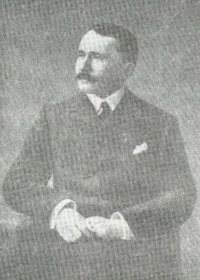 He
remarks: He
remarks:
"The vast extent of Indian cultural influences, from Central Asia in the
North to tropical Indonesia in the South, and from the Borderlands of Persia to
China and Japan, has shown that ancient India was a radiating center of a
civilization, which by its religious thought, its art and literature, was
destined to leave its deep mark on the races wholly diverse and scattered over
the greater part of Asia."
(source: The
Vision of India - By Sisir Kumar Mitra p. 178 and Main
Currents of Indian Culture - By S. Natarajan p. 50).
 Will
Durant (1885-1981) American historian, would like the West
to learn from India, tolerance and gentleness and love for all living things. Will
Durant (1885-1981) American historian, would like the West
to learn from India, tolerance and gentleness and love for all living things.
He
has observed:
"Indian
art had accompanied Indian religion across straits and frontiers into Sri Lanka,
Java, Cambodia, Siam, Burma, Tibet, Khotan, Turkestan, Mongolia, China, Korea
and Japan;
“in
Asia all roads lead from India.”
(source: Story
of Civilization: Our Oriental Heritage - By Will
Durant MJF Books. 1935. p. 605).
For
more refer to chapter on Sacred
Angkor,
Glimpses
XII to
Glimpses XV.
Reginald Le May ( ? )
author
of The
culture of South-East Asia;: The heritage of India,
observed:
“Indian art and culture seem naturally to have exercised an
extraordinary art fascination over the indigenous peoples of all these
territories, no doubt, owing to the attractions offered by Buddhism and
Hinduism, while Chinese art, not bearing any particular religious message,
apparently made but little impression inspite of the fact that they Chinese, too
sailed the southern seas in search of trade from very early time.”
He
wrote:
“The beginnings of Indian colonization
overseas eastward go back a very long way in time and it is almost certain that
the results seen today were, in the main, not achieved by military expeditions,
but by peaceful trading and religious teaching – and thereby all the more
permanent.”
(source:
Greater
India - By Arun Bhattacharjee -
Munshiram
Manoharlal Publishers Private Limited, 1981, New Delhi p. 1 - 20).
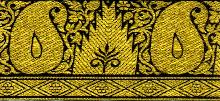
Introduction
Countries
Vietnam, Indonesia Java,
Sumatra,
Borneo,
Bali,
Burma,
Sri
Lanka,
Thailand,
Cambodia,
Malaya,
Philippines,
Japan, Korea,
Nepal,
Tibet, and Russia. For China
- refer to chapter India and
China.
Conclusion
Articles

Introduction:
India is a country of temples without
equal but there is a certain irony in that one of the largest and most dramatic
monuments to Hinduism rests not in India but thousands of miles away from the
subcontinent amid the ruins of a metropolis hidden in the jungles of Cambodia
(formerly known as Kamboja). One of the largest cities of the ancient world,
Angkor was built by King Suryavarnam II to honor Lord Vishnu, it is even larger
than the Vatican. To know and understand India one has to
travel far in time and space, to forget for a while her present condition, and
to have glimpses of what she was and what she did.
(source: Eastern Wisdom:
The Philosophies and Rituals of the East - By M. Jordan
p. 52).
 Henri
Mouhot (1826 -1861) a French naturalist and explorer, who had gone
to South-east Asia in the late 1850's and succumbed to fever there in 1861.
Mesmerized by what he saw at the temple of Angkor Vat, Mouhot in lyrical descriptions
said: Henri
Mouhot (1826 -1861) a French naturalist and explorer, who had gone
to South-east Asia in the late 1850's and succumbed to fever there in 1861.
Mesmerized by what he saw at the temple of Angkor Vat, Mouhot in lyrical descriptions
said:
"At the sight of this temple, one feels one's spirit crushed, one's imagination
surpassed. One looks, one admires, and, seized with respect, one is silent. For where are
the words to praise a work of art that may not have its equal anywhere on the globe? ...
What genius this Michalangelo of the East had, that he was capable of concaving such a
work.''
(source: Le Tour du Monde, 2-1863-299).
He said: "See Angkor and Die."
"What strikes the observer with
not less admiration than the grandeur, regularity, and beauty of these majestic
buildings, is the immense size and prodigious number of the blocks of stone of
which they are constructed. In this temple alone are as many as 1532 columns. What
means of transport, what a multitude of workmen, must this have required, seeing
that the mountain out of which the stone was hewn is thirty miles
distant!...."
(source: Angkor:
Heart of an Asian Empire - By Bruno Dagens p. 140-141).
"It is
grander than anything left to us by Greece or Rome." "To obtain any
idea of its splendor on one must imagine the most beautiful creations of
architecture transported into depths of the forests in one of the more remote
countries in the world."
Mahout recorded excitedly in his
diary for January 1860 after gazing on the 200-ft temple of Angkor Vat.
(source: The
World's Last Mysteries - Readers
Digest ASIN 089577044X p.
243).
At Ongcor, there are ...ruins of
such grandeur... that, at the first view, one is filled with profound
admiration, and cannot but ask what has become of this powerful race, so
civilized, so enlightened, the authors of these gigantic works?
(source: In
Mouhot's Footsteps ).
According to historian A.
L. Basham, "The whole of South-East Asia received most of its
culture from India. Early in the 5th B.C. century colonists from Western India
settled in Lanka. The Indian 'colonies' were peaceful ones, and the Indianized
chieftains who had learnt what India had to teach them."
(source: The
Wonder That Was India - By A L Basham p. 485).
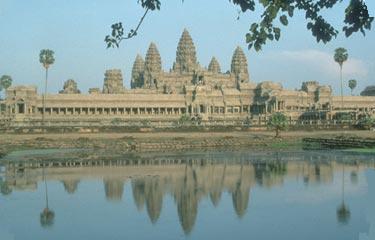 Henri
Mahout could hardly believe his eyes in 1860. Henri
Mahout could hardly believe his eyes in 1860.
He wrote of
"ruins of such
grandeur, remains of structures that must have been raised at such an immense
cost of labor, that, at the first view, one is filled with profound
admiration....One of these temples - a rival to that of Soloman, and erected by
some ancient Michael Angleo - might take an honorable place besides our most
beautiful buildings. It is grander than anything left to us by Greece and Rome,
and presents a sad contrast to the state of barbarism in which the nation in now
plunged."
To Mahout, those "prodigious works" were nothing
short of astounding.
(source: Splendors
of the Past: Lost Cities of the Ancient World
- National Geographic Society. p. 186).
Philip S. Rawson
writes in his book The
Art of South East Asia:
"The culture
of India has been one of the world's most powerful civilizing forces. Countries
of the Far East, including China, Korea, Japan, Tibet and Mongolia owe much of
what is best in their own cultures to the inspiration of ideas imported from
India. The West, too, has its own debts." But the members of that circle of
civilizations beyond Burma scattered around the Gulf of Siam and the Java Sea,
virtually owe their very existence to the creative influence of Indian ideas...
No conquest or invasion, no forced conversion imposed them. They were adopted
because people saw that they were good and that they could use them..."
"To
know Indian art in India alone,' says Sir
John Marshall, 'is to know but half its story. To apprehend it to the
full, we must follow it to central Asia, China and Japan; we must watch it
assuming new forms and breaking into new beauties as it spreads over Tibet and
Burma and Siam; we must gaze in awe at the unexpected
grandeur of its creations in Cambodia and Java."
(source: Discovery of India - By
Jawaharlal
Nehru. p. 200 -210). For
more refer to chapter on Glimpses
XII to
Glimpses XV.
 Will
Durant (1885-1981) American
historian, would like the West to learn from India, tolerance and gentleness and
love for all living things. Will
Durant (1885-1981) American
historian, would like the West to learn from India, tolerance and gentleness and
love for all living things.
He
has observed:
“Angkor
wat is a masterpiece equal to the finest architectural achievements of the
Egyptians, the Greeks, or the cathedral builders of Europe. An enormous moat,
twelve miles in length, surrounds the temple; over the moat runs a paved bridge
guarded by dissuasive Nagas in stone; then an ornate enclosing wall; then
spacious galleries, whose reliefs tell again the tales of the Mahabharata and
the Ramayana; then the stately edifice itself, rising upon a broad base, by
level after level of a terraced pyramid, to the sanctuary of the God, two
hundred feet high."
"Here
magnitude does not detract from beauty, but helps it to an imposing magnificence
that startles the Western mind into some weak realization of the ancient
grandeur once possessed by Oriental civilization."
(source: Story
of Civilization: Our Oriental Heritage - By Will
Durant MJF Books. 1935. p. 605).
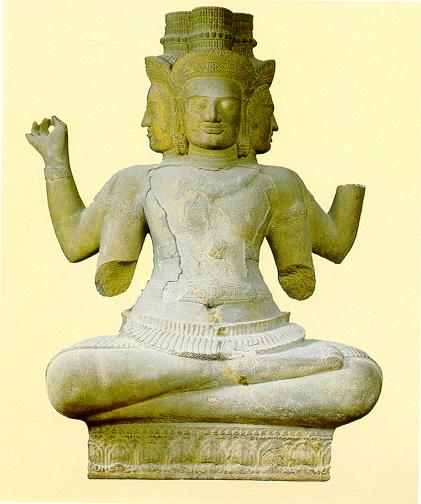
Hindu Trinity or Trimurti:
Brahma, Vishnu, and Shiva
"India
left the indelible impress of her high culture, not only upon religion, but also
upon art, and literature, in a word, all the higher things of spirit."
(image source: Angkor:
Heart of an Asian Empire - By Bruno Dagens p. 69).
For
more refer to chapters on Ethereal Prambanan, Sacred
Angkor
and Glimpses
XII to
Glimpses XIX.
***
M. Rene Grousset,
(1885-1952) French art historian, says: "In the high plateau of eastern
Iran, in the oases of Serindia, in the arid wastes of Tibet, Mongolia, and
Manchuria, in the ancient civilized lands of China and Japan, in the lands of
the primitive Mons and Khmers and other tribes of Indo-China, in the countries
of the Malaya-Polynesians, in Indonesia and Malay, India
left the indelible impress of her high culture, not only upon religion, but also
upon art, and literature, in a word, all the higher things of spirit."
"There is an obstinate
prejudice thanks to which India is constantly represented as having lived, as it
were, hermetically sealed up in its age-old civilization, apart from the rest of
Asia. Nothing could be more exaggerated. During the first eight centuries of our
era, so far as religion and art are concerned, central Asia was a sort of Indian
colony. It is often forgotten that in the early Middle
Ages there existed a "Greater India," a vast Indian empire.
A man coming from the Ganges or the Deccan to Southeast Asia felt as much at
home there as in his own native land. In those days the Indian Ocean really
deserved its name."
(source: Civilizations
of the East - By Rene Grousset
Vol. II, Chapter - Farther India and the Malay Archipelago p. 275 -343).
 "Indian
art in Java," adds Dr. Ernest Binfield
Havell, "has
a character of its own which distinguishes it from that of the continent from
whence it came. There runs through both the same strain of deep serenity, but in
the divine ideal of Java we lose the austere feeling which characterizes the
Hindu sculpture of Elephanta and Mamallapuram." "Indian
art in Java," adds Dr. Ernest Binfield
Havell, "has
a character of its own which distinguishes it from that of the continent from
whence it came. There runs through both the same strain of deep serenity, but in
the divine ideal of Java we lose the austere feeling which characterizes the
Hindu sculpture of Elephanta and Mamallapuram."
(source: The
Ideals of Indian Art - By Dr.
Ernest Binfield Havell p.169
Discovery of India - By
Jawaharlal
Nehru. p. 214).
Rabindranath Tagore has
said: "To know my country one has to travel to that age, when she realized
her soul and thus transcended her physical boundaries when she revealed her
being in a radiant magnanimity which illumined the eastern horizon, making her
recognized as their own by those in alien shores who were awakened into a
surprise of life."
Jawaharlal Nehru
has written: "For it was India that
functioned here and exhibited her vitality and genius in a variety of ways.
We see her bubbling over with energy and spreading out far and wide, carrying
not only her thought but her other ideals, her art, her trade, her language and
literature and her methods of government. She was not stagnant, or standing
aloof, or isolated and cut off by mountain and sea. Her people crossed those
high mountains and and perilous seas and built up, as (French art historian) Rene
Grousset says, ' a Greater India politically as little organized as
Greater Greece, but morally equally harmonious."
(source: The
Discovery of India - By Jawaharlal Nehru
p.207).
Jawaharlal Nehru
has lamented: "How few of us know of these great achievements of our past,
how few realize that if India was great in thought and philosophy, she was
equally great in action. Most westerners still imagine ancient history is
largely concerned with the Mediterranean countries, and medieval and modern
history is dominated by the quarrelsome little continent of Europe."
According to Indian historian, Dr.
K. P. Jayaswal, "Further India was
recognized as part of India in the Bharasiva-Vakataka period. In the Matsya
Purana, for the first time we find that
recognition. Between the Himavat and the Sea Bharatvarsha stands, but it covers
a larger area on account of Indians living in eight more islands (Dvipas). All
these Dvipas were to the east. The Malaya Peninsula was well-known to Indians at
the time, a fact evidenced by an inscription of the 4th century A.D. on a pillar
in the present district of Wellesley. Burma was
known as Indradvipa.
Ceylon was known as Lanka-Dvipa or Tamraparni. Similarly, Cambodia, Nicobar, Sumatra, Java and
Borneo were also known."
The Agni Purana, along with many other
Puranas, calls India
proper as Jambudvipa as distinguished from Dvipantara or India of the islands or
overseas India. Ancient Indians who explored the globe in times immemorial
had a three-fold motto expressed in the terms "Charaiveti" (Let
us move on and on), 'Krunvanto Viswam Aryan' (Let us make all people civilized,
well-behaved, dutiful, god-fearing, noble, educated etc.) and 'Wasudhaiva-Kutumbakam
(the whole world is one entity, one family).
 A
Sanskrit-Chinese dictionary compiled in Central Asia in the seventh and eighth
centuries calls the countries situated in the Southern Seas as Jipattala
which Sylvain Levi
interprets as the Indian archipelago and the neighboring islands. These two
Indias were called by the name of Bharatavarsha
which included the nine islands
of Dvipantara-Bharata,
each separated from the other by sea. The names of those
islands were Indra-dvipa, Kaseru, Tamravarna, Gabhastiman, Nagadvipa, Saumya,
Gandharva and Varuna. A
Sanskrit-Chinese dictionary compiled in Central Asia in the seventh and eighth
centuries calls the countries situated in the Southern Seas as Jipattala
which Sylvain Levi
interprets as the Indian archipelago and the neighboring islands. These two
Indias were called by the name of Bharatavarsha
which included the nine islands
of Dvipantara-Bharata,
each separated from the other by sea. The names of those
islands were Indra-dvipa, Kaseru, Tamravarna, Gabhastiman, Nagadvipa, Saumya,
Gandharva and Varuna.
Masudi, born in Baghdad, the Arab geographer, historian and philosopher,
states in his work called Muruj adh-Dhahab or 'Meadows of Gold' written in 942 A.D. that India in
those days "extended over sea and land and bordered on the country called
Zabag (Sumatra or Greater Java) ruled by the king of these islands."
Professor Sylvain Levi
has shown from references in the Ramayana, Mahabharata,
Mahaniddesa, and Brihat-Katha that
the products of Burma and Malaya Peninsula were known to Indian merchants and
sailors, and also some of its ports such as Suvarnakudya, Suvarnabhumi, Takkolam,
Tamlin and Javam from at least first century A.D.
The
Periplus of the Erythrean Sea written by a
Greek sailor of Egypt in the first century A.D. mentions many ports of India
then existing on its Western and Eastern coasts. Ptolemy
in his Geography written in the second century A.D. refers to the ports of
Malaya Peninsula, Java, and Sumatra and the Indian port of Palura from which
voyages were directly made to Malaya Peninsula. Ptolemy's reference in the
second century to Iabadiou certainly represents the Prakrit from of the
Sanskrit Yavadvipa.
Indian culture flourished, reaching islands as far as Borneo and Bali. Some of
it survives even today, evident from the quaint proto-Sanskritic names that
still prevail in Thailand, Malaysia, Cambodia and Indonesia. Borneo's capital, Bandar
Seri Begawan is a colloquialisation of Sri Bhagwan, Bali's
headquarters, Jeyapora, is nothing but
Jaipur, localised, just as Aranya Prathet in
Thailand is simply the jungle province or Aranya Pradesh. Fortunately, much of
the structure of the gigantic temple city of Angkor Vat has survived the ravages
of the Khmer Rouge, while Borobudur in Java still shines in resplendent glory.
"A
Tamil inscription found in Thailand, at the site of Takua Pa, testifies to
southeast Asia commerce with the Pallava region. A poem written by the 8th
century Vaishnava saint, Tirumangai, speaks
of ports where "ships rode at anchor, bent to the
point of breaking, laden as they were with wealth, with big-trunked elephants,
and with mountains of gems of nine varieties."
(source: Indian Art
- By Vidya Dehejia p.
186).
Names
like Indo-China. Further India, Insulindia, Indonesia, etc., which are applied
to various parts of South East Asia and the Far East are as significant as 'Ser-Inida.'
This region is geographically an extension of India and Ptolemy
rightly calls it 'Trans-Gangetic India.'
(source:
Cultural
Heritage of Ancient India - By Sachindra Kumar Maity p.121). For
a virtual tour of extensive art from Southeast Asia, visit Museum
Guimet).
 The
names that were given to these settlements were old Indian names. Thus Cambodia,
as it is known now, was called Kambhoja,
which was a well-known town in ancient India, as was Gandhara
in (present day Afghanistan). (Please refer to Glimpses
II for information on Afghanistan) The
names that were given to these settlements were old Indian names. Thus Cambodia,
as it is known now, was called Kambhoja,
which was a well-known town in ancient India, as was Gandhara
in (present day Afghanistan). (Please refer to Glimpses
II for information on Afghanistan)
What led to these extraordinary expeditions across perilous seas and what was
the tremendous urge behind them?
According to historian, Dr.
R. C. Majumdar (1888
- 1980), has pointed out that:
"If
literature can be regarded as a fair reflex of the popular mind, trade and
commerce must have been a supreme passion in India in the centuries immediately
preceding and following the Christian era."
All this indicates an expanding
economy and a constant search for distant markets. "The
military conquest of these early Indians colonists are important as throwing
light on certain aspects of the Indian character and genius which have hitherto
not been appreciated. But far more important is the rich civilization they built
up in their colonies and settlements and which endured for over a thousand
years. It is not known precisely when contact
began between India and Southeast Asia. There is enough references in Indian
books, accounts of Arab travelers, Chinese historical accounts, old
inscriptions, as well as the magnificent ruins of ancient monuments, like Angkor
and Borobudur. The old stories in Sanskrit
contain many accounts of perilous sea voyages and of shipwrecks. Both
Greek and Arab accounts show that there was regular maritime intercourse between
India and the Far East at least as early as the first century B.C.
(source: The
Discovery of India - By Jawaharlal Nehru p.200 -202).
India's Moonlight
Civilization
 Amaury de Riencourt
(1918 - ) was born in Orleans, France. He
received his B.A. from the Sorbonne and his M.A. from the University of Algiers.
He is author of several books including The
American empire and The Soul of India,
wrote: Amaury de Riencourt
(1918 - ) was born in Orleans, France. He
received his B.A. from the Sorbonne and his M.A. from the University of Algiers.
He is author of several books including The
American empire and The Soul of India,
wrote:
"The brightest sun shining over Southeast Asia in the first
centuries A.D. was Indian Civilization. Waves of Indian colonists, traders,
soldiers, Brahmins and Buddhist beat upon one Southeast shore after another.
Great military power based on superior technical knowledge, flourishing trade
fostered by the remarkable increase in maritime exchanges between India and
these areas, the vast cultural superiority of the Indians, everything conspired
to heighten the impact of the Indian Civilization on the Southeast Asian. Passenger
ships plied regularly between the Ganges, Ceylon and Malaya in the middle of the
first millennium A.D. Indian settlers from Gujarat and Kalinga colonized Java,
for instance, while others set out for Burma or Cambodia. Old
Indian books – the Kathasagara, the Jatakas and others – refer to these
wondorous regions that set the imagination of civilized Indians on fire, to
Suvarnabhumi, the fabulous “Land of Gold.” On the whole, the Indianization
of Southeast Asia proceeded peacefully. Local chiefs and petty chieftains were
admitted into the caste structure as Ksatriyas through a ritual known as
vratyastoma, performed by an Indian Brahmin. All
over Southeast Asia tremendous ruins are strewn, testifying to the immense
influence of Indian Civilization. "
Indian
Civilization prevailed over an immense area stretching from Afghanistan to the
Pacific, including most of what is known today as Southeast Asia.
Passenger ships plied regularly between the Ganges, Sri Lanka and Malaya in the
middle of the first millennium A.D. Indian settlers from Gujarat and Kalinga (Orissa)
colonized Java, for instance, while others set out for Burma or Cambodia. Old
Indian books - the Kathasaritsagara, the Jatakas and others -refer to these
wondrous regions that set the imaginations of civilized Indians on fire, to
Suvarnabhumi, the fabulous "Land of Gold" as Southeast Asia was then
known. And all over Southeast Asia tremendous ruins are strewn, testifying to
the immense influence of Indian Civilization. Side by side, the life history of
Gautama Buddha carved delicately in stone continues the bas-reliefs depicting
the legendary tales of Krishna, Vishnu and Rama. Moonlight
Civilization glittered in all their magnificence, reflecting Indian Civilization
at a time when it had been dealt a crippling blow at home, in India, after the
Mohammedans arrived.
Everywhere,
Indian influence prevailed over the Chinese, and for evident reasons: an
undoubted cultural superiority owing to much greater philosophic and religious
insight. Indian Civilization respected the political autonomy of its
colonies and the cultural freedom of all its units, and, on the whole, worked
through peaceful penetration. The Chinese, on the other hand, proceeded by
conquest, assimilation and absorption into all encompassing Chinese
Civilization.
(source: The
Soul of India - By Amaury de
Riencourt ISBN 0907855032 p. 157-162).
G
E Geraini commenting on Researches on Ptolemy’s Geography rightly observes:
“From the Brahmaputra and Manipur to the Tonkin Gulf
we can trace a continuous string of petty states ruled by those scions of the
Kshatriya race, using the Sanskrit or the Pali language in official documents
and inscriptions, building temples and other monuments of the Hindu style and
employing Brahmin priest at the propitiatory ceremonies connected with the court
and the state.”
Prof. Reginald Le May
wrote: “The beginnings of Indian colonization overseas eastward go back a very
long way in time and it is almost certain that the results seen today were, in
the main, not achieved by military expeditions, but by peaceful trading and
religious teaching – and thereby all the more permanent.”
(source:
Greater
India - By Arun Bhattacharjee -
Munshiram
Manoharlal Publishers Private Limited, 1981, New Delhi p. 1 - 20).
 Modern
historical research on Southeast Asia is in its formative stages and the
attention given to its ancient past has been much less than that given to later
periods. Western scholars are mainly stimulated by their colonial involvement in
the area and generally concentrate attention on their own activities. An idea of
the extent of knowledge about Southeast Asia may be gained from an European
scholar who wrote in 1861, that except for Burma, "the Indian countries
situated beyond the Ganges hardly deserve the attention of historians." Modern
historical research on Southeast Asia is in its formative stages and the
attention given to its ancient past has been much less than that given to later
periods. Western scholars are mainly stimulated by their colonial involvement in
the area and generally concentrate attention on their own activities. An idea of
the extent of knowledge about Southeast Asia may be gained from an European
scholar who wrote in 1861, that except for Burma, "the Indian countries
situated beyond the Ganges hardly deserve the attention of historians."
(source: Cited in George Coedes, Journal of South
East Asian History, September, 1964, p. 4).
"A
people with no long cultural history of their own (like the British) could not
be expected to be attracted by the ancient cultural past of the people they
dominated. Equally strange is the attitude of Indian historians towards the
cultural past of Southeast Asia. Most of them have remained indifferent, largely
because of inheriting a set system of academic training. The eastward expansion
of Hindu civilization has not yet been fully traced. On
the other hand, some non-Indian scholars, especially modern writers of secondary
works, tend to play down India's importance in the evolution of southeast Asian
civilization."
(source: India and World Civilization - By D. P. Singhal
p. 80-98).
The advent of Indians in Southeast Asia
has hardly a parallel in history. It cannot be equated with the arrival of
Europeans in America, because the Indians did not go to Southeast Asia as
strangers. In view of the ethnic affinities between the prehistoric
Austro-Asiatic races of India and those of Suvarnabhumi, contact between the two
regions may well go back to the remotest antiquity. Whatever the relationship
between the two regions may be the transplantation of Indian culture into
Southeast Asia began in prehistoric times with trade contacts.
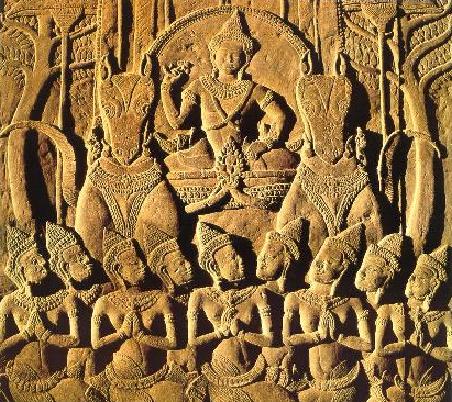
His chariot
drawn by prancing horse, Surya, the sun god rides the sky to a chorus of
worshippers.
(image
source:
Splendors
of the Past: Lost Cities of the Ancient World - National
Geographic Society. p.186-190).
For
more refer to chapters on Ethereal Prambanan
and Sacred
Angkor
and Glimpses
XII to
Glimpses XIX.
***
"This was the time of the great
Indian expansion, when seafaring merchants fanned out across the Indian Ocean
and brought to Southeast Asia a seething ferment of new ideas. From Burma to
Indonesia, they established a chain of settlements along the coasts from which
they traded for gold, precious stones, perfumes, and spices. The merchants
brought with them their religion, Hinduism and Buddhism, their literary
language, Sanskrit, their art and technology; and their science and
mathematics."
(source:
Splendors
of the Past: Lost Cities of the Ancient World - National
Geographic Society. p.186-190).
Indian culture,
secular and religious, had found a permanent home in Southeast Asia. This was a
peaceful process; unlike the Western newcomers in modern times, no forced
colonization occurred.
"Seldom has the world seen such a protracted and pervasive
cultural diffusion. It stands a monument to the vitality and magnetism of Indian
civilization."
(source:
A
History of World Societies - By Mackay Hill Buckler
p.318-319).
Indian culture penetrated the
countries of South-East Asia entirely by peaceful means. This was the result of
a series of enterprises by traders, adventurers, scholars and priests. Operating
from Indian settlements that had been founded in the 1st century, these men
brought the highly refined culture of India to
peoples whose way of life was perfectly suited to Brahmanic and Buddhist
teachings. Throughout this area Indianization took the form of the adoption of
Sanskrit as the official and sacred language, the introduction of the Indian
religions of Brahmanism and Buddhism, with their myths, philosophical systems
and traditions and the establishment of a political structure very close to that
of ancient India.
(source: The
Oriental World
- By Jeannine Auboyer
Landmarks of World's Art quoted from Appendix page).
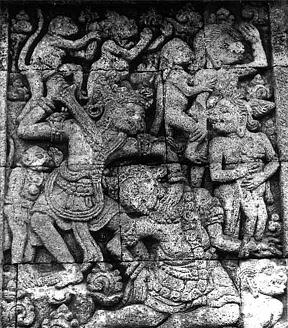 The
Ramayana reveals some knowledge of the eastern regions beyond the seas; for
instance Sugriva dispatched his men to Yavadvipa, the island of Java or Sumatra,
in search of Sita. It speaks of Burma as the land of silver mines. Tamil
literature contains references to tall roomy ships laden with goods returning
from eastern ports. Puranic cosmology and geographical divisions into varshas
and dvipas point to Indian knowledge of this area, although the knowledge of the
Puranic compilers was somewhat vague. Lord Ganesha
is found in Thai art especially around Sukhothai in central Thailand and Khmer
art of Cambodia. There are also spectacular images coming from Myanmar,
Malaysia, Laos and Vietnam - with both Buddhism and Hinduism intertwined and
Ganesha appearing predominantly as a protector and guardian. Nowhere
in South-East Asia is Ganesha as popular as in Indonesia: with most of Java and
Bali islands carrying forward continued worship of Ganesha. There are some rare
Ganesha bronzes as Vinayaka in Japan and some in China. The
Ramayana reveals some knowledge of the eastern regions beyond the seas; for
instance Sugriva dispatched his men to Yavadvipa, the island of Java or Sumatra,
in search of Sita. It speaks of Burma as the land of silver mines. Tamil
literature contains references to tall roomy ships laden with goods returning
from eastern ports. Puranic cosmology and geographical divisions into varshas
and dvipas point to Indian knowledge of this area, although the knowledge of the
Puranic compilers was somewhat vague. Lord Ganesha
is found in Thai art especially around Sukhothai in central Thailand and Khmer
art of Cambodia. There are also spectacular images coming from Myanmar,
Malaysia, Laos and Vietnam - with both Buddhism and Hinduism intertwined and
Ganesha appearing predominantly as a protector and guardian. Nowhere
in South-East Asia is Ganesha as popular as in Indonesia: with most of Java and
Bali islands carrying forward continued worship of Ganesha. There are some rare
Ganesha bronzes as Vinayaka in Japan and some in China.
Ganesha
has been a major deity, since the seventh and eighth centuries, in Thailand,
Cambodia and Vietnam. It was Ganesha in his role as
remover of obstacles that was primarily accepted in mainland Southest Asia.
Even today in Buddhist Thailand, Ganesha is regarded as god of success. It is
from Vinayaka that the old Myanmar name for Ganesha, Mahapinary
purha, was derived. Other names with a similar meaning occur frequently in
Cambodian inscriptions, such as Vighnesha and Vignesvara, both of
which mean "Lord of removing obstacles". Ganesha was extremely popular
in the art of Indonesian islands, especially of Sumatra and Java and compare
favorably with the eighth-century Ellora caves, in images, style and
iconography. At Candi Sukuh in central Java,
a remarkable fifteenth century relief shows three figures, with a dancing
Ganesha in the centre.
There are paintings and stone sculptures of the deity
found in China, apart
from the textual references to Ganesha in the Chinese Buddhist canon. In Japan,
there is the Shingon ritual practice that centres
on Ganesha, with texts tracing back to China. Nearer India, the
assimilation of the deity with the Buddhist images is almost complete in Tibet
and Nepal. In the Tibetan Buddhism, the practice associated with Ganesha, as
Buddhist Tantric deity, survives up to this day. In Jainism Ganesha occasionally
found a place alongside Mahabir. The
Tibetan Ganesha appears, besides bronzes, in the resplendent Thangka paintings
alongside the Buddha. In a single Kathmandu valley of Nepal, there are four
principal manifestations of "Binayak" in a protective role: Ashok,
Surya, Chandra and Bighna. In that valley, Ganapati guards the Buddhist viharas
where bhajans are sung in his praise.
Ganesha
is a vibrant presence whose benediction is sought by traders, travelers, artists
and statesmen. As lord of business and diplomacy, he sits comfortably on a high
pedestal outside Bangkok's World Trade Centre, where people offer flowers,
incense and a reverential sawasdee. A gilt Ganesha presides over the bustling
charivari of lucrative tourism in the lobby of the Rama Hotel. Another commands
the Isetan department store. Even Muslim Indonesia
reveres him and European scholars call him the 'Indonesian god of wisdom'. Bandung
boasts a Jalan Ganesa, and his image adorns 20,000 rupiah notes.
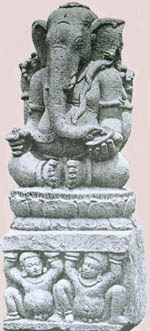
Lord Ganesha supported by figures of
gana. Ganesha literally means "Lord of the Gana".
(source: Ganesha:
Dominating Oriental Psyche - By Utpal
K. Banerjee Tour
India May 2001 and straitstimes.com).
***
 The Niddesa enumerates a series of
Sanskrit or Sanskritized toponyms whose identification with localities in
Southeast Asia has been proposed by French scholar, Sylvain Levi.
References are found in the Buddhist Jataka and the third Buddhist Sangiti council held at Pataliputra in 247 B.C.
during the reign of Asoka. Accounts of sea voyages, some of which ended in
disaster, are also recounted in other ancient texts, such as the Kathakosa, and
the Jain Jnatadharmakatha. The Kathakosa tells the story of Nagadutta who went
to Suvarnabhumi with five hundred ships to conduct a profitable trade. There
also numerous references in the Arthasashtra to those lands and places in
eastern and Southeast Asia, which were worthy of note from the economic,
commercial, or political viewpoint. For instance, it refers to a kind of
sandalwood, called Tailaparnika, which was produced in Suvarnabhumi. The Niddesa enumerates a series of
Sanskrit or Sanskritized toponyms whose identification with localities in
Southeast Asia has been proposed by French scholar, Sylvain Levi.
References are found in the Buddhist Jataka and the third Buddhist Sangiti council held at Pataliputra in 247 B.C.
during the reign of Asoka. Accounts of sea voyages, some of which ended in
disaster, are also recounted in other ancient texts, such as the Kathakosa, and
the Jain Jnatadharmakatha. The Kathakosa tells the story of Nagadutta who went
to Suvarnabhumi with five hundred ships to conduct a profitable trade. There
also numerous references in the Arthasashtra to those lands and places in
eastern and Southeast Asia, which were worthy of note from the economic,
commercial, or political viewpoint. For instance, it refers to a kind of
sandalwood, called Tailaparnika, which was produced in Suvarnabhumi.
(source: India
and World Civilization - By D. P. Singhal p.
80-98).
India's
contact by sea with China would also imply Indian contact with Southeast Asia.
All the Indian colonies were situated between two great countries and two great
civilizations - India and China. Some of them, on the Asiatic mainland, others
were on the direct trade route between India and China. Thus they were
influenced by both, religion and art came from India, and philosophy of life
came from China.
Sir John Malcolm wrote :
"Indian vessels "are so admirably adapted to
the purpose for which they are required that, not withstanding their superior science,
Europeans were unable, during an intercourse with India for two centuries, to suggest or
at least to bring into successful practice one improvement. "
It was also known that in the third century a transport of horses, which would require
large ships, reached Malaya and Southeast Asia.
In 1949, two scholars, Gordon
Ekholm and Chaman Lal,
systematically compared the Mayan, Aztec, Incan and North American Indian
civilizations with the Hindu-oriented countries. According to them, the emigrant
cultures of India took with them India's system of time measurement, local gods,
and customs.
(For more details, please refer to the chapter India
on Pacific Waves ) Gene
Matlock, author of India
Once Ruled the Americas!
states: The people of India have long known that their ancestors once sailed
to and settled in the Americas. They called America 'Patala,' The Underworld,'
not because they believed it to be underground, but because the other side of
the globe appeared to be straight down."
 Even in Cambodia and in the mighty remains of Angkor the only
artistic influence that can be detected is from India. But Indian art was
flexible and adaptable and in each country it flowered afresh in many new ways,
always retaining that basic impress which it derived from India. Even in Cambodia and in the mighty remains of Angkor the only
artistic influence that can be detected is from India. But Indian art was
flexible and adaptable and in each country it flowered afresh in many new ways,
always retaining that basic impress which it derived from India.
Sir John
Marshall, discoverer of the Indus Valley,
has referred to "the amazingly vital and flexible character of
Indian art." Indian art derives its basic character from certain ideals
associated with the religion and philosophic outlook of India. Dr. Ananda Coomaraswamy,
late curator at the Boston Museum, has said: " A more conscious of
sophisticated art could scarcely be imagined. Despite its invariably religious
subject matter, it is an art of "great courts charming the mind by their
noble matter, this is an art of "great courts charming the mind by their
noble routine."
(source: India Discovered -
By John Keay p. 162).
That Indian traders and settlers repeatedly undertook journeys to Southeast
Asia, despite the hazards and perils involved, speaks well for their physical
prowess, courage, and determination, even if allowance for the pull of profit is
made. Not only were the Indian traders vehicles of culture in this part of the
world, but everywhere trade has been a major factor in dissemination of culture.
Arthur Waley,
author of the book, The
Way and its Power, has declared that merchants were undoubtedly the main carriers of information
about the outside world, and disputes the assertion which is derived from false
analogy between the East and West that merchants are not likely to have been
interested in philosophy. Indian or Chinese merchants, in contrast to European
traders, were "reputedly capable of discussing metaphysical questions"
and there is ample testimony in Buddhist legend of such merchants.
"Each
blade of grass here breathes of Indian culture"- said Jawaharlal
Nehru, during his visit to Cambodia in1954 to commemorate the 2500th
birth anniversary of Buddha.
India, as
Jawaharlal Nehru observed way back in 1954, continues to breathe in these parts.
Lao religion is guided by both Hindu and Buddhist influences; the prevalent
language here has Sanskrit and Pali roots; Laos has evolved Ramayana Ballet like
an institution; ancient shivalingams were discovered in the south of Laos in
1999; Laotians greet their elders with a nop similar to the Indian namaste; they
take their shoes off outside their homes; temples in the ancient Laotian Capital
of Luang Prabang bear distinct Indian influences. All this and much more remain
literally miles away from the collective Indian consciousness. Similarly, the
ancient complex of Angkor Wat in Cambodia, rediscovered in the 1940s, is an
incredible testimony to the reach of Hindu religion and culture way back in the
12th century. The massive temple complex dedicated to Vishnu and bearing
frescoes from the Ramayana and the Mahabharata and detailed scenes of Samudramanthan
tells the story of a time when despite transport handicaps Indians traveled to
distant shores and placed their indelible signature on a civilization that
breathes to this day. That these great civilizations of the Mekong River (Mekong
is said to be a derivative for Ma Ganga) have kept alive a great Indian heritage
is a little-acknowledged fact in India, except of course their lifeless
documentation in Government records and academic research.
(source:
South
East Asia, truly India - By D. Ganguly - dailypioneer.com).
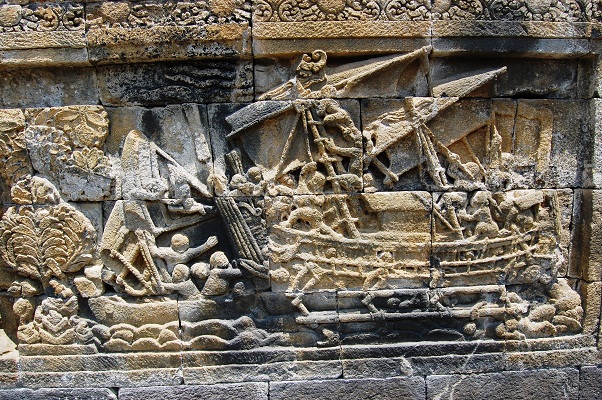
Ancient Indian
ocean-going ship arriving at Java, from a frieze of the Borobodur stupa.
(©
2011 image source:
webmaster's own collection of photos taken during a recent visit).
***
The discovery of monsoon made sea journeys between India and the Western
world safe and punctual, and the Roman demand for the luxury goods of the East
had reached fantastic proportions - far beyond what India alone could supply.
Consequently, the Indians went in increasing numbers to Southeast Asia looking
for those things that could be sold to the Romans at such good prices that Pliny
the Elder was to bewail this loss of blood inflicted to the Roman economy.
(source: India
and World Civilization - By D. P. Singhal p.
80-98).
In the beginning of the Christian era,
India lost Siberia as her most important source of gold, because political
upheavals and large-scale movements of the people of Central Asia in the last
two centuries B.C. cut off the trade route.
In Indonesia, Hinduism arrived first, but
it was made no conscious attempt to convert local peoples to their faith or
culture. They certainly did not impose it by force. Proselytism was precluded by
the very nature of the Hindu faith, which explains the general unconcern of
Indians with the Indianization of Southeast Asia. However, later Buddhist
missionaries worked for the spread of their faith. In some countries, like
Indonesia, Hinduism was intermingled with Buddhism, that Shiva and the Buddha
were described as brothers! Indeed, in Balinese temples where the religion is
Balinese Hinduism, Saiva and Buddhist priest sit side by side, although dressed
differently, as they bless the laity.
 Even the
remarkable Hellenization of
the Mediterranean world does not compare with the Indianization of Southeast
Asia. Even the
remarkable Hellenization of
the Mediterranean world does not compare with the Indianization of Southeast
Asia.
India was far from Southeast Asia.
There were far fewer Indians in Southeast Asia
than Greeks in the Hellenistic world, and those Indians had to contend with an
equally powerful Chinese civilization in an area mainly frequented by Chinese.
On the other hand, Greek civilization did not confront such a contrast of
cultural and ethnic types.
There is nothing in the Hellenistic world to compare with the Angkor Wat or
Borubudur. In addition, India contributed not only philosophy and thought, but
also a religion that still survives in most areas of Southeast Asia. Greek
religion is a thing of the past.
(source: India
and World Civilization - By D. P. Singhal p.
80-98).
The Hindu kingdoms that rose in
South-East Asia had no political connection with the mother country. Their
inscriptions are in Sanskrit hardly differing from those of any Indian States.
The Hindu epics and puranas still contribute to the themes for the theatre,
dances, and shadow plays and the marionette shows of Malaya and Java. The
influence of the Dharmasastras and the Arthasastra on the polity of these lands
is clearly traceable. Their languages have been enriched by contact with
Sanskrit. The scripts of all their languages are adaptations of Indian writing.
The kings performed vedic sacrifices; they used the Saka era and the lunar-solar
calendar. Tangible results of ancient Indian contact may be seen in their
monuments and temples. Till very recently at Phnom Penh in Cambodia and at
Bangkok in Siam brahmins of a very mixed descent followed Buddhism and wore the
sikha and upavita, and worshipped an assortment of Hindu and Buddhist
images.
Kambuja (Cambodia) according to
tradition was established by Kambu Svayambhuva after whom the country was named
Kambuja. Some of its famous rulers bore names ending in Varman as in South
Indian; examples are Jayavarman, Yasovarman, and Suryavarman. The law books of
Siam (Thailand) were framed on the basis of the Hindu dharmasastras and the
temples of its capital, Bangkok, were adorned with sculptures depicting scenes
from the Ramayana.
The peaceful and sympathetic methods
of Hindu colonists were in striking contrast to the Chinese policy of conquest
and annexation and to the severity and exploitation inherent in modern western
colonization.
(source: Advanced
History of India - By Nilakanta Sastri and G. Srinivasachari
p.231-233).
Reginald S. Le
May (1885 - )
author of The
culture of South-East Asia; the heritage of India
has observed:
"India, indeed,
began to exercise a profound cultural influence on her neighbors to the eastward
- Burma, Siam, Malaya, Cambodia, Java and Sri Lanka all falling beneath her
sway. And this, as far as one can may judge, almost entirely as a result of
trading and peaceful penetration by missionaries, merchants and others, and not
by force of arms." "The beginnings of Indian colonization overseas
eastward go back a very long way in time and it is almost certain that the
results seen today were, in the main, not
achieved by military expedition, but by peaceful trading and religious teaching
- and thereby all the more permanent."
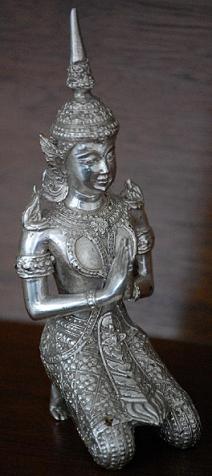

An Aspara and Hanuman from
Thailand.
(image source: webmaster's
own collection of art).
***
Contrasting the
Indian method with the Chinese
he remarked:
"Indian
religious art and culture seem naturally to have exercised an extraordinary
fascination over the indigenous peoples
of all these territories,
no doubt, owing to the attractions offered by Hinduism and Buddhism, while
Chinese art, not bearing any particular religious message, apparently made
little impression, in spite of the fact that the Chinese, too, sailed to
southern seas..."
(source: India
and The World - By Buddha Prakash
p. 7-8 Institute of Indic Studies Kurukshetra University 1964). For
more refer to chapter on Glimpses
XII to
Glimpses XV.
Top
of Page
Champa/Angadvipa on the coast of Annam
- Vietnam
Champa is the remotest colony in the East
and was less known than Kamboja and Java. According to Sir Charles Eliot,
the Hindu dynasty of Champa was founded between 150 and 200 A.D. The conquerors
were known as the Chams
and hence the country came to be known as Champa. Vietnam, figures
prominently as a stepping stone in the story of India's cultural expansion to
the Americas.
 According to historian Dr. K. P. Jayaswal,
"The State of Champa, according the Chinese authorities was founded in 137
A. D.
According to historian Dr. K. P. Jayaswal,
"The State of Champa, according the Chinese authorities was founded in 137
A. D.
Champa seems to have been mentioned under the name Angadvipa
by the Vayu Purana.
Again, Champa was probably the earliest colony, it being a key to the Chinese
trade and the point from the islands of Java and Borneo are easily
accessible." It maintained close relations with Funan, a fact which must
have been largely responsible for the penetration of Indian influence there.
A
Hindu dynasty was founded by Sri Mara in the second century A.D. A successor to
Sri Mara was the famous king called Bhadravarma.
He ruled over the Northern and Central portions of the kingdom comprising the
provinces of Amravati and Vijaya and possibly also the Southern province of
Panduranga. His greatest contribution was to Hindu culture was the building of
the temple of Bhadresvarasvamin (Shiva) at Myson which became the national
shrine of the Chams.
It is said that Bhadravarman abdicated his throne to spend
his last days on the banks of the river Ganges. This was followed by two
dynasties - the Panduranga
dynasty (757-860) and later by the Bhrigu
dynasty (860-985).
Champa passed through various dynasties and war with China
continued in the 3rd and 4th century. This was a period of political unrest in
China, and which gave Champa the opportunity to expand into Chinese territory.
Shiva and Vishnu were worshipped by various names. Goddess Laxmi was known
as Padma or Sri.
As
regards to literature, Sanskrit was the language of the learned. It was also the
official language of the country. Many kings of Champa were Sanskrit scholars.
Brahmi script was used in inscriptions.
The books were in use were the Vedas,
Sastras, the Epics, Buddhist philosophy, Saivism, Vaisnavism, Panini's grammar
along with its commentary, Dharmasastras of Manu and Narada, the Puranas and
classical Sanskrit literature including prose and Kavya literature.
Vietnam's Siva
Lingams
VIietnam,
June 23, 2001: A Siva Lingam monument, a relic from the lost Champa Kingdom,
stands proudly at the My Son site in Vietnam. Statues
depicting Lingam and Yoni can be found in Hindu-influenced cultures across the
entire Asian region. But the Cham religion in Vietnam has taken these
images and fashioned them into a distinctive and different form.
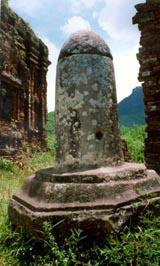 Lingam
and Yoni in the Cham religion differ from their Indian progenitors and their
presence in Vietnam is evidence of the profound influence of Indian culture and
religion in the country. Lingam
and Yoni in the Cham religion differ from their Indian progenitors and their
presence in Vietnam is evidence of the profound influence of Indian culture and
religion in the country.
It is also proof of the strong
sense of identity of the Cham people, who borrowed from Hinduism and created
statues and temples with a style all of their own.
Cham Linga
sculptures generally have a flat top, with only a few featuring spherical
shapes. they are generally found in three different styles: square; another in
two parts, one cylindrical and one square; and another has a cylindrical upper,
the middle is octagonal and the bottom is square. Linga and Yoni are usually
constructed as one structure. Traditionally only one Linga is attached to the
Yoni, but in some Cham sculptures many Linga can be found on a single Yoni
platform. The differences between Cham sculptures and those found else where in
the Hindu world demonstrate subtle changes from their origins.
(source:
Giving new
image and likeness to old beliefs - by
Nguyen Van Ngoc
http://vietnamnews.vnagency.com.vn/2001-06/23/Stories/29.htm).
For
more information on Vietnam refer to chapter on Glimpses
XIV
Top
of Page
Indonesia
Java or Yavadvipa
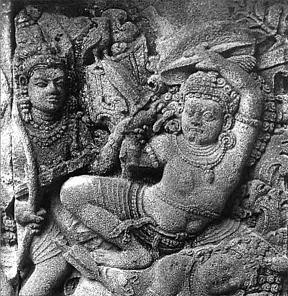 Sir Stamford Raffles
(1781-1826) the British Governor of Java,
in his book, History
of Java, II, p. 87, wrote: Sir Stamford Raffles
(1781-1826) the British Governor of Java,
in his book, History
of Java, II, p. 87, wrote:
“In the year 525 Saka era – 603 A.D., it being foretold
to a king of Gujarat that his country would decay and go to ruin, he resolved to
send his son to Java. He embarked with about 5000 followers in 6 large and about
100 small vessels, and after a voyage of four months reached an island they
supposed to be Java; but finding themselves mistaken, re-embarked, and finally
settled at Matarem, in the center of the island they were seeking….The prince
then found that men alone were wanting to make a great and flourishing state. He
accordingly applied to Gujarat for assistance, when his father, delighted at his
success, sent him reinforcement of 2000 people…From this period Java was known
and celebrated as a kingdom; an extensive commerce was carried on with Gujarat
and other countries, and the bay of Matarem was filled with adventurers from all
parts.”
(source:
Periplus of the Erythrean Sea - W.H. Schoff p.
245).
There is an Indian tradition at that
"those who go to Java do not come back." There are many views
regarding the beginnings of Hindu colonization of Java. One view connects the
original colonies under their leader called Ajisaka with the heroes of the
Mahabharata and Astina or Hastinapura. Another view traces the colonization to
Gujarat. The third view traces it to Kalinga (Orissa) from where "twenty
thousand families were sent to Java by the prince of Kalinga." The Javanese
era started by Ajisaka starts from 78 A.D. which is also the beginning of the
Saka era of India. According to historian, R. C.
Majumdar, "The Indian settlement in Java
dates from the 2nd century A.D. if not earlier, and the Hindu culture flourished
there till the end of 15th century.
Fa-hien,
the Chinese traveler, visited Java on his way to China in about 418 A.D. He
tells that there was no Buddhism only Hinduism in Java. The name Java is taken
from the Sanskrit word Yava.
The kings of Java had their names which ended with Varman.
There were several kingdoms in Java. Four
Sanskrit inscriptions have been found me in Western Java mention a king named Purna-varmarn.
One of them calls his grandfather Rajarishi and another ancestor his father Rajadhiraja. The latter is said to have dug the Chandrabhaga which reached the
sea after passing by the capital city. Purna-varman himself dug a similar canal
called the Gomati river. Purna-varman ruled in the sixth century A.D. and his
capital was known as Taruma.

Shiva Maheshvara - Java.
For
more refer to chapters on Ethereal Prambanan
and Sacred
Angkor
and Glimpses
XII to
Glimpses XIX.
***
Both Hinduism and Buddhism flourished
here. We find worship of Shiva, Vishnu and Brahma in the temples. Grants of land
were made to the priests. Images of Mahadevi and Durga have been also found.
Literature was mainly theological. We have the Arjuna-vivaha, poetic rendering
of the Bharat-yuddha from the Mahabharata, Kavi Ramayana, Vritta Sanchaya.
The temple of Java are a standing
monuments of the influence exercised by Indian thought and art in moulding the
development of the entire art of Java. The monumental history begins in Central
Java, with the Chandi (temple) Punta Deva, Bhima, Sri Khanda, Pawon and Arjuna.
Shiva temple of Chandi Bayon near Borobudur. Superb images of Vishnu, Shiva,
Brahma, Ganesh, and Agastya Siva-guru have been found from there. The best
temples at Prambanam are known as Chandi Loro Jauggrang. These are considered
the greatest Hindu monuments of Java.

Indic
Influence is South east Asia: Chandi Sukuh Hindu Temple dedicated to Bhima of
Mahabharata in Indonesia strikes a disquieting alien chord with its flat topped
step pyramid and its Mayan calendar carvings.
In
general layout, the temple conforms to the plan of most other Hindu temples.
There are three precincts, consisting of three concentric terraces. However,
where most temples would have a large square shrine, Chandi
Sukuh has a pyramid reminiscent of Mayan structures from
Central America
.
The
religious structures in Java are commonly called Chandis, a term which
originally meant a commemorative building.
For
more refer to chapter on
Ethereal Prambanan
and India on Pacific Waves
and Seafaring
in Ancient India.
***
The worship of Rishi
Agastya, the sage responsible for the diffusion of Hindu culture in
Java, the frequent occurrence of Ganesha images, the organization of rural
economy and village administration, the shadow and puppet plays and Vedic hymns
and rituals of Bali, all point to the extension of Indian religious and cultural
influences of these islands. A statue of Agastya is
found at Candi Banon - early 9th century Batavia)
(source: The
Indians And The Amerindians - By Dr. B. Chakravarti. Self-Employment
Bureau Publication Calcutta p. 32)
Prambanan - slender and ethereal Hindu
temples
 Built
in the 10th century, this is the largest Shiva
compound in Indonesia. Rising above the center of the last of these concentric
squares are three temples decorated in relief illustrating the epic of the
Ramayana, dedicated to the three great Hindu divinities (Brahma, Shiva and Vishnu)
and three temples dedicated to the animals who serve them. The Prambanan
temple,
which was dedicated to Lord Shiva, was started in 856 AD and completed in 900 AD
by King Daksa. Earlier Shiva temples were built in 675 AD on the Dieng mountain
range, southwest of Medang Kamolan, the capital of the Mataram Kingdom. Built
in the 10th century, this is the largest Shiva
compound in Indonesia. Rising above the center of the last of these concentric
squares are three temples decorated in relief illustrating the epic of the
Ramayana, dedicated to the three great Hindu divinities (Brahma, Shiva and Vishnu)
and three temples dedicated to the animals who serve them. The Prambanan
temple,
which was dedicated to Lord Shiva, was started in 856 AD and completed in 900 AD
by King Daksa. Earlier Shiva temples were built in 675 AD on the Dieng mountain
range, southwest of Medang Kamolan, the capital of the Mataram Kingdom.
Dr. Ananda Coomarswamy,
late curator at the Boston Museum, was of the opinion that
"the Prambanam reliefs are, if anything,
superior to those of Borobudur and certainly more dramatically conceived. "
Of the sculptures in Prambanum, Sir
Stamford Raffles
(1781-1826) the British Governor of Java
and author of History
of Java says:
"In the whole course of my life
I have never met with such stupendous and finished
specimens of human labor, and of the science and taste of ages long
since forgot, crowded together in small a compass as in this little spot."
(source: History
of Java. volume II p. 15).
Ancient
Hindu Temples Unearthed in Perfect Condition in
Indonesia
Researchers
from the government’s Archaeological Office in
Yogyakarta
, excavated for 35 days and eventually unearthed two 1,100-year-old small
temples. “The temples are not so big, but they have features that we haven’t
found in
Indonesia
before." Historians
believe that Hinduism spread in Java in the fifth century, followed three
centuries later by Buddhism. Kingdoms hewing to both Hindu and Buddhist beliefs
flourished in Java before Islam in the 15th century. But Islam itself
incorporated beliefs and ceremonies from the other two religions. Just as some
unearthed temples in east Java have a Hindu upper half and a Buddhist lower
half, some early mosques had roofs in the shape of Hindu temples, said Timbul
Haryono, a professor of archaeology at Gadjah Mada University here and an expert
on Hinduism in Southeast Asia. Early mosques faced not
in
Mecca
’s direction, but west or east in the manner of Hindu temples.

Lord Ganesha statue found at
the 1,100-year-old
two temples.
***
“Things didn’t change all of a sudden,” Mr. Haryono said. “Islam was
adopted through a process of acculturation.” In
Indonesia
’s arts, like the wayang shadow puppetry that dramatizes Hindu
epics, or in people’s private lives, traces of the earlier
religions survive, he said. Food, flowers and incense still accompany many
funerals for Muslims, in keeping with Hindu and Buddhist traditions. “Hinduism
was
Indonesia
’s main religion for 1,000 years,” he said, “so its influence is still
strong.” “This is
Indonesia
,” said Suwarsono Muhammad, an official at the Islamic University. In the long
history of
Indonesia
, we have proven that different religions can live peacefully.”
(source:
Ancient
Hindu Temples Unearthed in Perfect Condition in
Indonesia - Hinduism today.com).
The Indonesian Ramayana
The archaeological evidence of the Rama story in Indonesia
dates back to the ninth century AD, the period of the Sri
Vijaya Empire. It consists of the bas-reliefs at Prambanan
in Central Java. These bas-reliefs, considered to be the most splendid depiction
of the Rama story in sculpture, do not follow the Valmiki Ramayana. Other
reliefs, dating back to the Majapahit period
(13th and 14th centuries AD) are at Panataran in East
Java. These reliefs have greater affinity with the Valmiki story.
Indonesia thus presents evidence of both the Valmiki and
non-Valmiki versions of the Rama story. The various written versions in
Indonesia are the Kakawin Ramayana, the Serat Ram, the Javanese Uttarakanda, the
Carit Ramayana the Serat Kanda, and the Rama King.
The Kakawin Ramayana of Yogisvara
is considered to be the oldest written version of Rama story in Indonesia. It is
placed between the 10th and 13th centuries AD. The story,
with some variations, follows the traditional version given by Valmiki. Its
source, however, is considered to be the Bhaatikavya, a Sanskrit work on the
Rama story written in Kashmir in the 5th century AD. The Kakawin,
like the Bhattikavya, does not contain the Uttarkanda (the last book of the
Valmiki Ramayana), nor does it give a detailed account of the Balakanda. This
suggests that the Kakawin is based on a version of the Rama story which existed
before the First and Last Books of Valmiki were added.
The Serat Ram and the Carit Ramayana are the modern
adaptations of the Kakawin. The Javanese Uttarkanda is a separate work
describing the genealogy of Raksasas (demons) and monkeys. The Uttarakanda,
although it exists as a separate work, complete the Kakawin Ramayana, which ends
only with the Yudhakanda (The Book on War). These works, along with the Kalawin,
constitute one of the groups of Ramayana which, with slight variations, follow
the Valmiki story.
In the beginning of the Yuddhakanda (the Book of War), the
author disgresses from the main story and begins to relate the life of the
Pandavas, the characters of the Mahabharata. He then resumes the Rama story. An
interesting observation in Indonesia is that while the oldest written version is
the Kakawin, the oldest bas-reliefs at Prambanan do not agree with the Kakawin
story, which follows the Valmiki Ramayana.
(source:
Hinduism in Thai Life - By Santosh N Desai p 102 – 105).
The "Wayang kulit" of Java is performed
with leather puppets held by the puppeteer, who narates the story of one of the
famous episodes of the Hindu epics, the Mahabharata or the Ramayana. The
Indonesian flag, being of two colors, bears the Sanskrit name Dwivarna. The famous dance dramas of Java and Bali
are derived from Hindu stories and often feature fragments from the Ramayana
and Mahabharata Hindu epics.
'Not very far from Borobudur, writes Dr. Raghuvira
'is the complex Prambanam, the like of which is known neither to India nor to
any other neighboring or distant land...Here are the life-cycles of Lord Krsna
known as Krsnayana parallel to the Ramayana, the powerful dragon being torn
asunder by the superb arms of the Divine Krsna. In another place is the scene of
Kumbhakarna being awakened by conches and screeches of elephants, a portrayal of
the highest order....
 The five
cardinal points of the Indonesian constitution are also designated by the
Sanskrit word Panchashila. Its airline is called
Garuda,
the Sanskrit name for the eagle carrier of Lord Vishnu. The old Javanese
alphabet derives from the Pallava script of South India. One such inscription
was found in the south-eastern region of Borneo on four octagonal stone pillars,
written in Sanskrit in a 4th century Indian script. Indonesians still follow the
Vedic year and call it Sakh-Samvat.
The five
cardinal points of the Indonesian constitution are also designated by the
Sanskrit word Panchashila. Its airline is called
Garuda,
the Sanskrit name for the eagle carrier of Lord Vishnu. The old Javanese
alphabet derives from the Pallava script of South India. One such inscription
was found in the south-eastern region of Borneo on four octagonal stone pillars,
written in Sanskrit in a 4th century Indian script. Indonesians still follow the
Vedic year and call it Sakh-Samvat.
(source: Proof of Vedic Culture's Global
Existence - By Stephen Knapp p. 230).
Rabindranath Tagore
has said about the culture of Indonesia: '
I see India all around me.'
And
in Indonesia, such words as 'sea' and 'ship' are recognizable for their Tamil
roots.'
Lara Jonggrang
Temple - commonly called the Prambanan Temple
"The great temple of Shiva at
Lara Jonggrang is chiefly famous for its relief's which narrate before our eyes
the whole story of the Ramayana. We need only mention a few particularly fine
scenes from the principal series: that of Dasaratha saluting Visvamitra, with
the noble, majestic figures of the old King; Rama drawing the bow of Shiva and
thus winning the hand of the fair Sita - the first of the scenes in which we see
the hero in the elegant attitude of an archer, together with a Sita whose
slender, undulating form reminds us of the daughters of Mara at Borobudur.."
(source: Civilizations
of the East - By Rene Grousset
Vol. II, Chapter - Farther India and the Malay Archipelago p. 294).
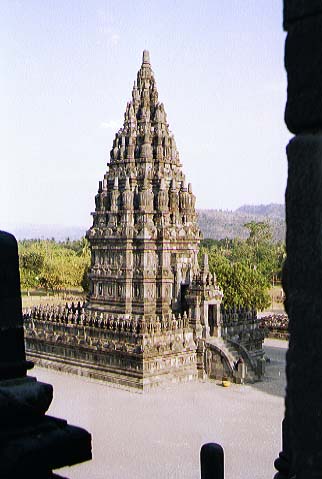
Lara Jonggrang Temple -
commonly called the Prambanan Temple
Refer to chapter on
Ethereal Prambanan
***

Gold foil inscribed
in old Javanese script, 'Om
Rudrayana puh swaha',
meaning 'This is the way of the god Rudra who destroys heaven.'
 Gedong
Songo Gedong
Songo
The monuments of
Gedong Songo display greater unity and with the ex-ception of the later Group I,
must have been built in one period between 750 and 775 AD. Although the
architectural compositions are similar to Dieng, the site plans of the groups
are quite varied, and later exerted an influence on monuments of a much larger
scale. Group III includes three main shrines oriented toward the west, dedicated
to the three gods of the Trimurti: in the centre Siva, on the north Vishnu, on
the south Brahma. In
front of the Siva sanctuary a small building sheltered the vehicle of Siva, the
bull Nandin. This latter edifice (right) is particularly interesting because it
shows that a manual was used in its design. Because the proportions of this
edifice were designed for a larger structure, the entrance would have been only
one metre high. To avoid this inconvenience, the architect lowered the base of
the opening so that it cut through the mouldings of the temple foot. This detail
shows how, despite variations and alterations, the architects wished to conform
to Indian texts which governed architecture.
Candi (temple)
Badut - Dating
from the late eighth century, Badut was constucted at the time when the
Sailendra kings ruled in central Java. The Dinoyo inscription, which is written
in Sanskrit, records the construction of a temple dedicated to Agastya by the
son of a king named Devasingha ruling a kingdom called Kanjuru-han.

Siva linga in
Candi Badut, the oldest known temple in east Java.
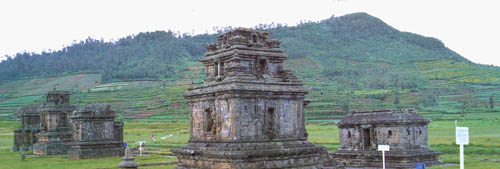 Candi (temple) Arjuna
Candi (temple) Arjuna
This temple forms part of the
largest remaining architectural complex on the Dieng Plateau. The interior
houses a Siva lingga and yoni. The shrine is equipped with
a makara-headed spout which was meant to channel the fluids used to lustrate the
linga from inside the shrine to the outside. In this way, commoners who were not
allowed into the shrine's interior could still benefit from the ceremonies held
inside by collecting the water which flowed from this conduit, believed to be
full of supernatural fertility and other qualities. This feature is common in
Indian temples but in Indonesia only Candi Arjuna possesses such a sutasoma.
This suggests that Candi Arjuna may be the oldest surviving building in Java,
and perhaps even in all of Southeast Asia. The structure is relatively complete
except for the pinnacle which has vanished.
(source: Indonesian
Heritage).
Arnold Hermann
Ludwig Heeran
(1760-1842) wrote: "The colonization of
the eastern coast of Java by Brahmins is "a fact well established by Sir
Stamford Raffles."
(source: Historical
Researches - By Arnold
Hermann Ludwig Heeran
Vol II p. 303 and Hindu
Superiority - By Har Bilas Sarda p. 183).
From the Indian soil
where he originated, prince Rama "traveled" across the oceans for 20
centuries, and made his way into the heart and mind of Indonesians.
His life story, as recorded in Ramayana by Indian poet Valmiki around the
seventh century BC, has undergone many transformations over the years. But one
thing that persists throughout the recurrent transformation in Java and Bali is
the perception of human values inherent in Ramayana's characters and, most
importantly, its philosophical concept that governs human relationships that are
but universal ideals. The transformation -- as a result of the cross-cultural
exchange between India and Indonesia through trade dating back as early as the
beginning of the first millennium AD -- and the many faces of Rama that were
reconstructed by ancient Indonesian poets and scholars,
(source:
Unveiling
Rama in Indonesia - By Ivy Susanti -
jakaratapost.com).
For
more information on Java refer to chapters on
Ethereal Prambanan
and Glimpses
XII.
Top
of Page
Sumatra - Suvarnadvipa/Samudradvipa
 The
geographical position of Sumatra marks it out as pre-eminently the earliest
Hindu settlement in Indonesia. At the earliest Hindu kingdom in Sumatara was
Sri-Vijaya (Palembang). It was founded in or before the
fourth century A.D. It rose to great eminence towards the close of the seventh
century A.D. By that time, it had conquered another Hindu kingdom of Malaya and
established its supremacy over the island of Banka. ITsing,
the Chinese traveler, tells us that trading ships sailed between India and
Sumatra. The city of Sri Vijaya was the chief center of trade with China. There
was regular navigation between it and Kwan-Tung. The
geographical position of Sumatra marks it out as pre-eminently the earliest
Hindu settlement in Indonesia. At the earliest Hindu kingdom in Sumatara was
Sri-Vijaya (Palembang). It was founded in or before the
fourth century A.D. It rose to great eminence towards the close of the seventh
century A.D. By that time, it had conquered another Hindu kingdom of Malaya and
established its supremacy over the island of Banka. ITsing,
the Chinese traveler, tells us that trading ships sailed between India and
Sumatra. The city of Sri Vijaya was the chief center of trade with China. There
was regular navigation between it and Kwan-Tung.
The empire was also a sea Power
based on trade. Hence you find that it had ports wherever it could get the
smallest footing. Indeed a remarkable feature of the settlements of the
Sumatrian State was their strategic value - that is to say, they were carefully
located at places where they could command the surrounding seas. Often they were
in pairs to help each other in maintaining this command. Thus, Singapore, which
is a great city now, was originally a settlement of the Sumatran colonists. The
name, as you will notice, is a typical Indian name: Singhpur.
The Sumatran people had another settlement just opposite the Straits, facing
Singhpur. Sometimes they would stretch an iron chain right across the Strait and
so stop all ships from passing till they paid heavy tolls.
At the beginning of the eleventh century the Chinese Emperor sent a gift of a
number of bronze bells to the Sumatran King. In return the latter sent pearls
and ivory and Sanskrit books. There was also a letter inscribed on a golden
plate in "Indian characters." it is said.
(source: Glimpses
of World History - By Jawaharlal Nehru p. 135).
Heine-Geldern
has described the influence of South India on Sumatra.
He has said that:
"We can safely assert that Sumatra has not only once been colonized by
Hindus, but that, owing to more than a thousand years of close connection, it
became an integral part of the Greater Indian cultural area."
Borneo or Varunadvipa
The earliest evidence of Hindu colonies of
Borneo is furnished by inscriptions which have been referred on paleographic
grounds to about 400 A.D. These inscriptions refer to king Mula-varman, son of
Asva-varman and grandson of king Kundunga. Mula-varman performed a sacrifice
known as Vahusu-varmakam and gave 20,000 cows to the Brahmins. A number of Hindu
and Buddhist images have been found in Kombeng.
 This
explains why this period in history is called the Period of Hindu Kingdoms. It
lasted from ancient times to the 16th Century AD. Because the culture and
civilization, which emanated from the Hindu and Buddhist religions, were
syncretized with the local cultural elements, the period was also referred to as
the Hindu-Indonesian period. Indian culture and customs were introduced, such as
the system of government in a monarchy, the ancestry system, the organization of
military troops, literature, music and dances, architecture, religious practices
and rituals, and even the division of laborers into castes or varnas. The Hindu
literary works known as Vedas and the "Mahabharata" and
"Ramayana" epics were also introduced through the wayang, or
shadow-play performance, which is still very popular in many parts of present
day Indonesia. The first indian migrants
came primarily from Gujarat in Southeast India during the first Christian era. This
explains why this period in history is called the Period of Hindu Kingdoms. It
lasted from ancient times to the 16th Century AD. Because the culture and
civilization, which emanated from the Hindu and Buddhist religions, were
syncretized with the local cultural elements, the period was also referred to as
the Hindu-Indonesian period. Indian culture and customs were introduced, such as
the system of government in a monarchy, the ancestry system, the organization of
military troops, literature, music and dances, architecture, religious practices
and rituals, and even the division of laborers into castes or varnas. The Hindu
literary works known as Vedas and the "Mahabharata" and
"Ramayana" epics were also introduced through the wayang, or
shadow-play performance, which is still very popular in many parts of present
day Indonesia. The first indian migrants
came primarily from Gujarat in Southeast India during the first Christian era.
The Caka period in Indonesia witnessed the
introduction of the Sanskrit language and the Pallawa script by the Indian
Prince Aji Caka (78 AD). The Devanagari script of the sanskrit language was also
used, as shown in ancient stone and copper inscriptions (paracasthies) which
have been unearthed. The language and script were adopted and called the Kawi
language and included words and phrases derived from Javanese.Early trade
relations were established between South India and Indonesia. Sumatra was then
named Swarna Dwipa of "the island of gold, " Java was called Java
Dwipa or "the Rice island," and a Hindu kingdom of Crivijaya in
Sumatra and Nalanda in South India were not comfirmed to religious and cultural
exchanges. They later developed diplomatic relations, and even covered a wide
range of trade.
The influx of Indian settlers continued during
the period from the first to the seventh century AD. Peacefully and gradually
the Hindu religion spread throughout the archipelago. It was adopted by all
layers of the people of Java, but limited to the upper classes on the other
islands. (source: http://www.indonesia-ottawa.org/indonesia/general/history.html#hindu)
The sultan of Brunei (in Borneo) bore the title
of Seri Bhagwan meaning Shree Bhagwan (Lord Almighty). Sarawak, a part of Borneo
happened to lose its suzerainty to the British. Yet the white English ruler of
Sarawak too was known as the Rajah.
Bali or Balidvipa
Bali has been justly called the island of thousands of
temples. Despite the loss of about 2500 temples due to earthquake, it still
contains more than 4500 large and important temples. The most important is Pura
Besakih, at  the foot of the mountain Gunung
Agung, and associated with the Hindu
Trinity. It is said to have been founded by Warmadeva Keshari (Wira Dalem
Kesari). The island of Bali possesses the unique distinction of being the
only Hindu colony in the Far East which still retains its old culture and
civilization to a considerable extent. Islam has failed to penetrate into this
island. The people are still proud of their
Hindu connection. Vishnu, Shiva, Indra, Ganesh, Nandi, Krishna and the heroes of
the Mahabharata are still known. The Vedas, the Mahabharata and the Ramayana are
found there although not in Sanskrit but in Kawi. The
people call their deities as Devas. We have the temples of Durga and the images
of Durga and Kaliki. The bodies of the dead are still burnt. the foot of the mountain Gunung
Agung, and associated with the Hindu
Trinity. It is said to have been founded by Warmadeva Keshari (Wira Dalem
Kesari). The island of Bali possesses the unique distinction of being the
only Hindu colony in the Far East which still retains its old culture and
civilization to a considerable extent. Islam has failed to penetrate into this
island. The people are still proud of their
Hindu connection. Vishnu, Shiva, Indra, Ganesh, Nandi, Krishna and the heroes of
the Mahabharata are still known. The Vedas, the Mahabharata and the Ramayana are
found there although not in Sanskrit but in Kawi. The
people call their deities as Devas. We have the temples of Durga and the images
of Durga and Kaliki. The bodies of the dead are still burnt.
Sir Stamford Raffles
while describing the small island of Bali, situated towards the east of Java
says: "Here, together with the Brahminical religion, is still preserved the
ancient form of Hindu municipal polity."
(source: Hindu
Superiority - By Har Bilas Sarda p. 184).
For more information on Bali refer to chapter on Glimpses
XIII.
***
Sailing
down the seas of history
Charting the coastline from Mumbai to the very
end of Gujarat, where India ends and Pakistan begins, the 1,000 nautical mile
voyage that will end on February 11 is in preparation for another, more
ambitious voyage. The sailors, calling themselves the Maritime Exploration and
Research Group, is getting ready to follow the path of ancient Indian mariners
from south India all the way to Indonesia.
Inspired by the Chola kings of the 11th century, who
discovered the present-day Indonesian islands of Sumatra and Bali, the group is
preparing to replicate the feat using traditional instruments and a boat
resembling the vessels of yore.
Called the Simulation of Chola Navigation Techniques, the forthcoming expedition
will attempt to cover the distance between Nagapatnam in southern India and the
Indonesian islands."The expedition will aim to show that our ancient
seafarers were in no way inferior to their Western counterparts," said B.
Arunachalam, a researcher who is the moving spirit behind the expedition. The
expedition has cost the team members nearly Rs.100,000 but they have received
substantial assistance from the Indian Navy.
(source: Sailing
down the seas of history -
newindpress.com). For more refer to Hindu
Indonesia.com).
Hindu
Presence in Indonesia
Indian culture, often in its pristine form, makes an
appearance whichever way one turns in this sprawling archipelago. The
national language, Bahasa Indonesia, is replete with Sanskrit words.
So are names of people: Nirmala, Apsara, Rati, Dewi and so on. The given name of
bdurrahman Wahid's wife is Sinta,
which is Indonesian for Sita. And the Vice-President is, of course, named Megawati
Sukarnoputri, the daughter of Indonesia's first President, Sukarno.
At a traffic roundabout on one of the busiest arteries of the
city stands a monumental sculpture facing the central bank on one side and the
national monument on the other. It depicts Krishna and
Arjuna in a chariot drawn by several horses. The sheer size and magnificence of
this famous scene from the Mahabharata has no parallel in India.
The mottos inscribed on government buildings are equally
revealing. When you drive past the defence ministry -- called the Yuddha
Graha -- you come across the following inscription engraved in marble
on the archway: Chatur Dharma, Eka Karma.
Further down the road is the ministry of sports known as the Krida Bhakti.
The government has also named its national airlines after Garunda
Airways.

An image of Lord Ganesha is printed
on high denominational currency notes. Ganesha statues are seen
everywhere, including a magnificent one at the entrance of the presidential
palace. Statues of dwarpalakas are to be
found in front of both public and private buildings. The exhibits in the
national museum are almost entirely Hindu or Buddhist: Shiva and Parvati,
Vishnu, Durga, Vigneshwara, Brahma Deva...
(source:
Hindu
presence in Indonesia - media watch.org).
The
royalty and aristocracy of South East Asian ruling kingdom too
favored the flamboyant gold shot woven cottons and silks of
India, the gossammar thin muslin, the intricate weaves and motifs
which embellished textiles. The genesis
of the lasting impact on South East Asia of Indian culture perhaps
lies in the "Greater India" Hindu kingdoms of Khamboja,
Champa, Annam Srivijaya and Madajahit, which flourished in (modern
day) Malaysia, Vietnam, Indonesia and the Philippines and lasted
from Second Century A.D. to the 15th Century.

Ceremonial
cloth and sacred heirloom, Coromandel coast, India,
The
textiles of Indonesia have, across time, also incorporated and
integrated Hindu's symbols such as the Garuda, the naga, the
lotus, the elephant, the "mandala diagrams"
For
more refer to chapters on Ethereal Prambanan
and Sacred
Angkor
and Glimpses
XII to
Glimpses XIX.
***
The textiles of Indonesia have, across time, also incorporated and
integrated Hindu's symbols such as the Garuda, the naga,
the lotus, the elephant, the "mandala diagrams"
and so on. In fact, the country's textiles — from apparel to
ritualistic hanging, ship cloth and sacred religious cloth —
demonstrate the remarkable exchange of ideas, materials, designs
and images resulting from Indonesia's Indian trade links.
(source:
Textiles
as History - By Pushpa Chari - hindu.com). For
more refer to chapter on Glimpses
XII to
Glimpses XV.
Top
of Page
Burma
or Indra Dvipa
Burma was known as Indra-Dvipa. Hindu settlements began to be established
in Burma before the first century A.D.
It is contended that this relationship can be
traced back to the time of the Buddha. Hindu settlements were set up in Arakan,
Tagaung, Srikshetra, Thaton and Pegu at a very early period. Literary and
archaeological evidence shows that the entire culture and civilization of Burma
was borrowed from India and not from China. Ptolemy, the geographer, tells us
that in the 2nd century A.D. many places in Burma had Sanskrit names. Indian
religions flourished in Burma. Many religious structures having the images of
Indian gods and goddesses have also been found from Burma.
Burmese history
had been buried for a century or more as part of "Farther India."
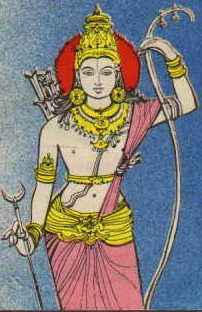 The Burmese who are most Hinduised are the Mons. Some of their places have Pali
names. The Mon kingdom in the 6th century A.D. was known as Dvaravati. The
rulers of this kingdom had mostly Indian names. The Mon
settlements of the Hindus were known as Ramanna-desa. The Burmese who are most Hinduised are the Mons. Some of their places have Pali
names. The Mon kingdom in the 6th century A.D. was known as Dvaravati. The
rulers of this kingdom had mostly Indian names. The Mon
settlements of the Hindus were known as Ramanna-desa.
(Note:
Considered
the national epic of Myanmar, the Yama
Zatdaw, an adaptation of Ramayana,
has been influenced greatly by Thai, Mon, and Indian versions of the play. The
Burmese name for the story itself is Yamayana,
while zatdaw refers to the acted play.
The Yama Zatdaw was introduced by oral
tradition during King
Anawratha's reign. It was influenced greatly by Ayutthaya
Kingdom, during which various Konbaung
Dynasty kings invaded the kingdom. The invasions often brought back spoils
of war, including elements of Ramakien
(Thai version of Ramayana) into the epic. The characters of Yama Zatdaw share
the same features and characteristics as those in the original story. However,
in acting, the costumes are a mixture of Bamar
and Thai
elements. The names of the characters, in general, are Burmese transliterations
of the Sanskrit names. Rama
is known as Yama; Sita
is known as Thida; Ravana
is known as Dat-thigiri).
Ramayana and Mahabharata the two ancient
Sanskrit epics of India exerted a profound impact upon the cultures of South
East Asia and have played no small role in the Indianisation of the major
portion of that region. Out of ASEAN TEN at least seven nations Myanmar, Laos,
Cambodia, Thailand, Malaysia, Brunei and Indonesia have received the influence
of Hindu culture since the early days of Indian colonisation.
(source: Ramayana
in Myanmar).
The Pali literature of Burma on law is
based on the Dharamsastras of Manu, Narada and
Yajnavalkya.
The art of Burma was
also influenced by the Indian art.
In Burma, the finest temple is the Ananda at Pagan. It occupies the center of a
spacious courtyard which is 564 ft square. There is no doubt of its derivation
from Indian type. Temples of the same type existed in Bengal and most probably
suggested the model of the Ananda temple.
Charles Duroiselle, pioneer of Burmese Studies in
France, who composed the Epigraphia Birmanica,
says on the Ananda temple:
" There can be no doubt that the architects who planned and built the
Ananda temple were Indians. Everything in this temple from Sikhara to the
basement as well as the numerous stone sculptures found in its corridors and the
terra-cotta...adoring its basement and terraces, bear the indubitable stamp of
Indian genius and craftsmanship...In this sense, we may take it, therefore, that
the Ananda, though built in the Burmese capital, is an Indian temple."
(source: Ancient
India - By R. C. Majumdar p. 497).
Michael
Symes author of An
Account of an Embassy to the Kingdom of Ava in the Year 1795 p.
326 says: "The Burmans, we are told, call their Code generally, Dharmasath
or Shastra; it is one among the many commentaries of Manu. Mr. Syme speaks in
glowing terms of the Code."
(source: Hindu
Superiority - By Har Bilas Sarda p. 180-181).

Hindu Bas-relief inside the Nan
Paya Temple, Burma.
***
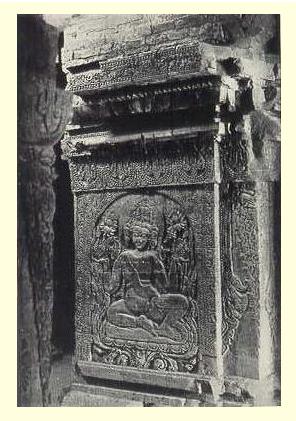
Nan Paya temple at Myinkaba,
Near Pagan, Burma.
***
The names of its rivers are Sanskrit names
- Irrawati, Brahmaputra and Chindwin. Her head of state is also known as Adipadi,
which is the Sanskrit Adhaipati, referring to the chief executive.
Indian-Hindu influences must
certainly have been the strongest if not the earliest influence upon that
countryside. The Sarabha Gate, still
standing, is commonly associated with 9th century King
Pyinbya. It is the frontispiece to what will become Pagan a century
and half later. It is Hindu in design and structure. This great out reach of
Indian-Hindu style is also evident in some 9th century ruins surrounding Angkor
Wat. This Hindu push through India, Burma, Thailand, Indochina and Indonesia
must have been an extraordinary one, certainly equal to the Graeco-Roman thrust
on the Mediterranean cultures. It left behind an indelible imprint upon the
civilizations of those two peninsulas of Asia stretching deep into the Indian
Ocean. The mark of its art, architecture, and its religion are still to be found
in these Buddhist and Moslem countries.
Horace
Hayman Wilson
who used to be professor of Sanskrit
at Oxford University, says:
"The civilizations of the
Burmese and the Tibetans is derived from India."
(source: Hindu
Superiority - By Har Bilas Sarda p. 180).
Top
of Page
Sri Lanka
or Lankadvipa
Sri Lanka, Sinhala, or Ceylon, which is
India's closest neighbor to the south, was possibly the first country in
southern Asia to feel the impact of Indian immigration.
 The
Hindu epic, Ramayana, narrates the story in which Rama's conflict with Ravana,
the king of Lanka, is the central theme. Although
the history of ancient Sri Lanka is largely a complex of legends, it is
undoubted that the early settlers of Lanka came from India. The Aryan migrants,
members of the Sinhalas or the Lion Tribe, named their new home Sinhaladvipa,
from which has derived its later variations: the Portuguese Ceilao or Zeylan, or
the English Ceylon. The coming of the Aryans is represented in the Mahavamsa by
the story of Prince Vijaysimha who came from northern India in the sixth century
B.C. Close ties were established during the reign of Asoka, with the
introduction of Buddhism. In Buddhist shrines, The
Hindu epic, Ramayana, narrates the story in which Rama's conflict with Ravana,
the king of Lanka, is the central theme. Although
the history of ancient Sri Lanka is largely a complex of legends, it is
undoubted that the early settlers of Lanka came from India. The Aryan migrants,
members of the Sinhalas or the Lion Tribe, named their new home Sinhaladvipa,
from which has derived its later variations: the Portuguese Ceilao or Zeylan, or
the English Ceylon. The coming of the Aryans is represented in the Mahavamsa by
the story of Prince Vijaysimha who came from northern India in the sixth century
B.C. Close ties were established during the reign of Asoka, with the
introduction of Buddhism. In Buddhist shrines,
Hindu
deities occupy honored places. Vishnu is particularly popular in Sinhalese
Buddhist temples, for he is not considered a rival of the Buddha but the
protector of Sri Lanka. Hindu temples were also
built, for example, the Shiva temple at
Polonnaruva dating probably from the 11th century resembles the South Indian
Chola buildings.
Top
of Page
Thailand - Siam
According to S.
Poolthupya from the Thammasat University in Bangkok, Thailand:
"In the Thai version or
Ramayana called the Ramakien, brotherly love
can be considered one of the main themes. One can see clearly which kind of
brotherly love is worthy when one reads the Ramakien, a Thai work of great
literary value. The Ramakien shares the universal idea of brotherly love as
expressed in the original Ramayana from India."
(source: Indian
Epic Values: Ramayana and Its Impact - By G. Pollet p. 215-219).
 Hindu civilization spread to Siam in early
times from about 2nd century A.D. The Hindus set up many colonies in Siam and
the most important of them was Dvaravati which
ruled from Cambodia to the Bay of Bengal up to the 10th century A.D. when it was
overthrown by the Kaundinya kingdom. Numerous excavations have yielded extensive
evidence of Indianization and some remarkable piece of art. Because Siam
increasingly assimilated Indian art and culture into a local pattern, relics of
pure Indian descent are more ancient than those reflecting local influences. One
of the most remarkable sites in the center of Siam, is Srideb
(Crip-teb), where statues of Hindu deities bearing Sanskrit inscriptions of the
5th and 6th century have been discovered. The ast of Srideb is of excellent
quality and provides a link between Indian art and the art of Southeast Asia. Dr. Quartich Wales considered Srideb the oldest known Hindu temple in
Southeast Asia. Hindu civilization spread to Siam in early
times from about 2nd century A.D. The Hindus set up many colonies in Siam and
the most important of them was Dvaravati which
ruled from Cambodia to the Bay of Bengal up to the 10th century A.D. when it was
overthrown by the Kaundinya kingdom. Numerous excavations have yielded extensive
evidence of Indianization and some remarkable piece of art. Because Siam
increasingly assimilated Indian art and culture into a local pattern, relics of
pure Indian descent are more ancient than those reflecting local influences. One
of the most remarkable sites in the center of Siam, is Srideb
(Crip-teb), where statues of Hindu deities bearing Sanskrit inscriptions of the
5th and 6th century have been discovered. The ast of Srideb is of excellent
quality and provides a link between Indian art and the art of Southeast Asia. Dr. Quartich Wales considered Srideb the oldest known Hindu temple in
Southeast Asia.
Although
Thailand is today predominantly Buddhist, there are traces of Hindu influence,
visible mostly in the court ceremonials. Until recently, the court Brahmins cast
horoscopes, consulted omens, and performed worship of both Hindu and Buddhist
deities. Ceremonies of coronation, tonsure, cremation, and lesser rites
connected with agriculture were developed by the Brahmins. The Siamese call
their coronation by its ancient Sanskrit designation, the rajabhiseka.
The entire complex of coronation ceremonies,
such as homa (sacrifice of Fire), purificatory rites, ablutions, anointment, are
closely modelled on Hindu rituals, and are presided over by the Brah
Maha Raja Guru. The tonsure ceremony in Siam is
a rite of initiation of youths, corresponding to the Hindu Cudakarma Mangala,
which is very important Hindu Samskara. Cremation, an old vedic rite, is the
only means of disposal of the remains of deceased royalty in Siam.
Even today, the kings of Thailand bear
the royal title is Rama, a Hindu
avatar, and the story of Ramayana is depicted on the palace and temple walls of Bangkok.
Hindu festivals such as Dashahara, commemorating the victory of Rama over the
demon king Ravana, are still observed in Thailand. The Thais, like the Hindus,
still believe in Vishnu or Naryana (Phra Narain), and Mahadeva or Siva, and
dislike the asuras (asuns) as the enemies of the devas.

Even today, the kings of Thailand bear
the royal title is Rama, a Hindu
avatar, and the story of Ramayana is depicted on the palace and temple walls of Bangkok.
For
more refer to chapters on Ethereal Prambanan
and Sacred
Angkor
and Glimpses
XII to
Glimpses XIX.
***
Famous Indian works, such as the Ramayana and Mahabharata, and the Shakuntala
have formed the basis of some of the outstanding Siamese literature. The
Ramayana, known in Siam as the Ramakien "Ram
- Akhyan" where Akhya is
a Sanskrit word meaning "rendition of the story of". It is regarded as Siamese classic. Knowledge of this work is as
essential for a cultured Siamese as Homer used to be for an European. The epic
and Puranic literature of India
constituted the principal source of inspiration not only for Siam but for the
whole of Southeast Asia. It provided the themes for classical theatre, shadow
theatre, and marionette shows.
Indian influence is clearly seen on
Siamese dance, drama, and music. Many of the themes of Siam's various
dance-dramas (lakhon-ram) are drawn from Indian stories: for example, the
story of Savitri and Satyavan. Many Thai
musical instruments closely resemble those of India. The Siamese legal system is
directly descended from the Manusmriti. The Hindu Dharmasastras,
provided the framework for Siamese justice.

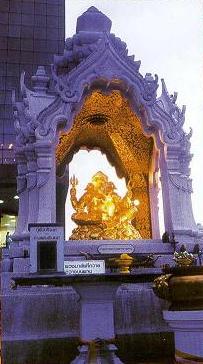
Lord Ganesha sits majestically
in an exquisitely crafted shrine outside the Bangkok World Trade Center,
Thailand.
(image source: Hinduism Today - December 1999).
For
more refer to chapters on Sacred
Angkor
and Glimpses
XII to
Glimpses XIX.
***
Top
of Page
Malaya
or Sri Vijaya
The greatest of the states was the
Sailendra Empire, or the empire of Shri
Vijaya, which became the dominant power
both on sea and land in the whole of Malaysia by the eighth century. The
empire was also a sea Power based on trade. Hence you find that it had ports
wherever it could get the smallest footing. Indeed a remarkable feature of the
settlements of the Sumatrian State was their strategic value - that is to say,
they were carefully located at places where they could command the surrounding
seas. Often they were in pairs to help each other in maintaining this command.
Thus, Singapore, which is a great city now, was originally a settlement of the
Sumatran colonists. The name, as you will notice, is a typical Indian name: Singhpur.
The Sumatran people had another settlement just opposite the Straits, facing
Singhpur. Sometimes they would stretch an iron chain right across the Strait and
so stop all ships from passing till they paid heavy tolls.
(source: Glimpses
of World History - By Jawaharlal Nehru p. 135).
 The language and
culture of Malaysia is still Sanskrit and Hindu. Take the name of Kuala Lumpur.
The suffix 'Pur' is a Sanskrit termination used to signify a township. the
original Sanskrit name was Cholanampuram. i.e. the city of the Cholas. A city in
mountainous north Malaysia is called Sungei Pattani. Its ancient Sanskrit name
was Shringa Pattan meaning ' a mountain city.' Another town Seramban is 'Shree
Ram Van' i.e. the bower of Lord Rama.
The language and
culture of Malaysia is still Sanskrit and Hindu. Take the name of Kuala Lumpur.
The suffix 'Pur' is a Sanskrit termination used to signify a township. the
original Sanskrit name was Cholanampuram. i.e. the city of the Cholas. A city in
mountainous north Malaysia is called Sungei Pattani. Its ancient Sanskrit name
was Shringa Pattan meaning ' a mountain city.' Another town Seramban is 'Shree
Ram Van' i.e. the bower of Lord Rama.
In
Malaysia, the commander-in-chief is still called Lakshmana -- a remnant of the
role played by Rama's brother in the battle of Lanka.
Of Shailendra,
the mighty man of war and conquest and other achievements, Dr.
H. G. Quaritch Wales has written:
"This
great conqueror, whose achievements can only be compared with those of the
greatest soldiers known to western history, and whose fame in his time sounded
from Persia to China, in a decade or two built up a vast maritime empire which
endured for five centuries, and made possible the marvelous flowering of Indian
art and culture in Java and Cambodia. Yet in our encyclopedias and
histories...one will search in vain for a reference to this far-flung, empire or
to its noble founder...The very fact of such an empire ever existed is scarcely
known, except by a handful of Oriental scholars."
(source: In 'Towards
Angkor' Harrap, 1937).
Indian literature also mentions kingdoms,
Kalaspura, Kamalanka (Karmaranga), which were probably in the Malay Peninsula,
Kala (Kedah), and Pahang. In the Puranas, mention is often made to Katahadvipa
(Kataha), which was included amongst the nine divisions of the world across the
seas, and to which regular voyeages were undertaken from Tamaralipti. Various
other references to katahadvipa are found in Sanskrit dramas and stories. The
Tamil epic, Silappadkiaram, of the second century contains description of tall,
roomy ships entering a city in South India laden with a variety of goods and
spices from a Malayan port called Tondi. Malaysia peninsula derives its name
from the Sanskrit word Malaya. Its other name was Vanga from its abundance of
'tin' because in Sanskrit 'Vanga' means tin.
Kedah
is by far the most important of Malayan sites. The Pallavas founded settlements
in Kedah, on the Bujang River, whose temple ruins have yielded an image of
Ganesha and other objects of Saiva faiths.
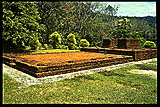 The Kedah
Annals record how on conversion to Islam the
Malays destroyed all the idols they were accustomed to worship, together with
the idols handed down from their ancestors. Concepts of state and kingship in
Malaya, royal titles such as Seri Paduka,
ceremonies connected with coronation, and royal prerogatives are clearly of
Indian inscription. Malaya's literature and
folklore are deeply influenced by the Hindu epics, the Ramayana, and the
Mahabharata. Her language has many Sanskrit
loan words, and until the introduction of Arabic and, later Roman script, Indian
scripts were used in Malaya and the Archipelago. The Kedah
Annals record how on conversion to Islam the
Malays destroyed all the idols they were accustomed to worship, together with
the idols handed down from their ancestors. Concepts of state and kingship in
Malaya, royal titles such as Seri Paduka,
ceremonies connected with coronation, and royal prerogatives are clearly of
Indian inscription. Malaya's literature and
folklore are deeply influenced by the Hindu epics, the Ramayana, and the
Mahabharata. Her language has many Sanskrit
loan words, and until the introduction of Arabic and, later Roman script, Indian
scripts were used in Malaya and the Archipelago.
The Ramayana has captivated the inhabitants of South East
Asia for centuries and has been written, recited, sculpted and performed from
Cambodia to Bali. In Malay culture, the Ramayana tradition has been kept alive
by only three of these media, for sculptures and reliefs have not survived the
passage of time.
Nothing comparable to the poetry of Yogisvara’s Old
Javanese Ramayana Kakawin survives in Malay. The Rama Saga is, however,
well-known in Malay and exists in both literary and oral forms, the latter still
enjoying considerable popularity in the north and west Malaysia, where they form
the basic repertoire of the Malay shadow-play.
The literary Malay version, the Hikayat Seri Rama, is
interrelated with a group of popular Javanese versions.
(source: The Ramayana Tradition in
Asia - Edited by V Raghavan. chapter - The Malayan Ramayana – By Amin
Sweeney
p 122 – 151).
Ramayana
Casts Its Ancient Spell In
Singapore
With
numerous heroes and villains and its powerful feel-good message of good
triumphing over evil, the Ramayana has been one of the
great epic poems of Indian culture for centuries. Originally
attributed to the Hindu Sanskrit poet Valmiki, the story has been retold and
adapted over time by poets, scholars and everyday storytellers.
It has also captured the
imagination of many other cultures beyond its origins in
India
. In Southeast Asia, scenes from the Ramayana can be found in places ranging
from Prambanan, a 9th-century Hindu temple compound in Yogyakarta in central
Java, Indonesia, to the magnificent 12th-century Angkor Wat in Cambodia.
“Ramayana Revisited: A
Tale of Love & Adventure,” an exhibition that is running at the Peranakan
Museum, Singapore until Aug. 22, underlines the cross-cultural power
of the popular epic.
As it spread across
Southeast Asia, the Hindu tale was adapted, with localized versions emerging
like the Ramakien in
Thailand
or the Reamker in
Cambodia
. Through the display of shadow puppets, papier-mâché masks, sculptures and
paintings on paper and cloth sourced from the permanent collection of the
Asian
Civilisations
Museum
, this exhibition narrates the Ramayana story according to a 17th-century
version from north
India
. The narrators of this version are Lava and Kusha, the two sons of Rama, and it
tells the classic tale of their father’s epic quest to rescue their mother,
Sita, from the demon king Ravana with the help of Rama’s devoted friend
Hanuman and his army of monkeys.
While some of the
artifacts that are shown are ancient and quite rare, like a 12th-century bronze
Hanuman from the late Chola period in the
Indian state of Tamil Nadu, or a 12th-to-13th century bas-relief from the state
of Madhya Pradesh of a reclining image of Vishnu on cosmic snake, others —
especially shadow puppets and masks — are more recent. Some have been
commissioned by the museum over the past 15 years.
(source:
Ramayana
Casts Its Ancient Spell In
Singapore - Hinduism today.com).
Top
of Page
Cambodia or
Khamboja
Cambodia boasts the largest temple complex
in the world, named Ankor, from the Sanskrit meaning "the capital
city".
It was the water which brought the
richness and cultural evolution to this country. According
to an ancient Sanskrit inscription, Cambodia was born from the water. Being the
oldest Indianised state in Southeast Asia, its religion was Hinduism.
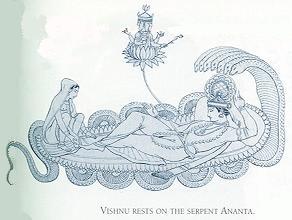 It was built in the ninth century C. E. in honor of the Hindu god
Lord Vishnu. The
complex extends over an area more than twice the size of Manhattan and took
thirty-seven years to complete. Its physical
and spiritual grandeur is found elsewhere only in ancient Greece, Egypt and
among the Mayan and Aztec civilizations. Cambodia's principle river is today
called Me Kong, which scholars say is derived from India's Ma Ganga (Mother
Ganges). Kaundinya founded the prosperous kingdom
of Khamboja in the first century A.D. We are told that some of the essential
elements of Indian culture spread to Kamboja, eg, Sanskrit, Saivism, Vaishnavism, and Buddhism. It was built in the ninth century C. E. in honor of the Hindu god
Lord Vishnu. The
complex extends over an area more than twice the size of Manhattan and took
thirty-seven years to complete. Its physical
and spiritual grandeur is found elsewhere only in ancient Greece, Egypt and
among the Mayan and Aztec civilizations. Cambodia's principle river is today
called Me Kong, which scholars say is derived from India's Ma Ganga (Mother
Ganges). Kaundinya founded the prosperous kingdom
of Khamboja in the first century A.D. We are told that some of the essential
elements of Indian culture spread to Kamboja, eg, Sanskrit, Saivism, Vaishnavism, and Buddhism.
James Ferguson,
author of History of Indian
and Eastern Architecture, wrote in 1876,
"To the historian of art the wonder is to find temples with such a singular
combination of styles in such a locality - Indian temples constructed with
pillars almost purely classical in design, and ornamented with bas-relief so
strangely Egyptian in character."
(source: Angkor: Heart of an Asian Empire
p. 43).
Professor and archaeologist Bernard
Philippe Groslier, author of Angkor,
Art and Civilization
wrote: "The expansion of India towards the countries of the East, at
the very moment when by a striking coincidence China seemed to be moving
southwards to encounter it, constitutes one of the turning-points of history,
paralleled by the expansion of Greece and Rome."
(source: Splendors
of the Past: Lost Cities of the Ancient World - National
Geographic Society. p. 190).
S.
Sarin, has written: "The Cambodian country, with its own
language, knows Sanskrit as well since the dawn of history and some learned
scholars speak of Indo-Khmer culture, as the aspects of question are
interconnected to one another. So viewed, the deep cause of the noble sense of
gratefulness in Cambodian behavior is firstly due to the Ramayana,
which had been well-known, for example through the bas-relief of Angkor
Temples." In Cambodian language, Tin Gun
meaning "knowing, acknowledging what has been done, grateful." In
Cambodian way of speaking, people have Tin, and Gun (guna),
"quality."
(source:
Indian
Epic Values: Ramayana and Its Impact - By G. Pollet p.222-228).
Around the second century AD, Indians arrived in
Funan (South Cambodia-Vietnam), and a Brahmin named
Kaundinya married the daughter of the local
Naga king and introduced Hindu religion and culture and Sanskrit to the region.
The power center shifted to Angkor from the ninth to fifteenth centuries A.D.
The founder of the first Angkor at Rolous (ancient Hariharalaya) and the
Devaraja or god-king cult was Jayavarman II. His descendant Indravarman I built
the first temple-mountain or Mount Meru at Bakong and a temple tank or
Indratataka, both of which were to define Angkorean temples of the future. Three
other Angkorean sites were Phnom Bakheng on a natural hill, Yashodharapura where
the king Suryavarman II built the great Angkor Wat, and the mysterious Angkor
Thom.
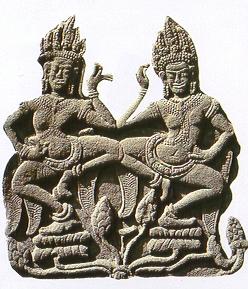 Cambodia achieved what the Indian subcontinent
never could: the confluence of Hindu cults and regional cultures. The culture is
frozen in time, limited to concepts from the Vedas, Ramayana and Mahabharata,
unlike temples in India that are Puranic. Every temple recreates the ancient
concept of jambudvipa with Mount Meru at the center, as a tall multi-tiered
pyramid. The garbagriha at the top of Meru is a literal recreation of the womb
of the universe, and the deity within is the source of creation, something we
forget when we enter crowded sanctum sanctorums in India. The outside walls are
decorated with the gods, dvarapalas and beautiful apsaras with whom the local
women identify. The main object of veneration may be Shiva or Vishnu or Buddha,
but the walls would contain stories of Rama, Krishna and the ascetic Shiva on a
hill. The most popular motif is the samudra manthana, the churning of the ocean
by the devas and asuras for the divine nectar, where the tortoise is the base on
which Mount Meru is placed and churned, unlike later Indian literature where
Vishnu is identified with the tortoise. There are several Sanskrit inscriptions
written in Pallava Grantha. Cambodia achieved what the Indian subcontinent
never could: the confluence of Hindu cults and regional cultures. The culture is
frozen in time, limited to concepts from the Vedas, Ramayana and Mahabharata,
unlike temples in India that are Puranic. Every temple recreates the ancient
concept of jambudvipa with Mount Meru at the center, as a tall multi-tiered
pyramid. The garbagriha at the top of Meru is a literal recreation of the womb
of the universe, and the deity within is the source of creation, something we
forget when we enter crowded sanctum sanctorums in India. The outside walls are
decorated with the gods, dvarapalas and beautiful apsaras with whom the local
women identify. The main object of veneration may be Shiva or Vishnu or Buddha,
but the walls would contain stories of Rama, Krishna and the ascetic Shiva on a
hill. The most popular motif is the samudra manthana, the churning of the ocean
by the devas and asuras for the divine nectar, where the tortoise is the base on
which Mount Meru is placed and churned, unlike later Indian literature where
Vishnu is identified with the tortoise. There are several Sanskrit inscriptions
written in Pallava Grantha.
Angkor Wat is truly a wonder. It occupies
about 500 acres bounded on all four sides by a wall and an enclosed tank.
The
causeways, flanked by enormous nagas and lions, represent rainbows. The temple
is 65 metres high, made up of three platforms, progressively smaller, with
covered galleries defining the borders, and is a replica of the cosmos.
The
first level contains 1200 square metres of carved sandstone galleries
illustrating scenes from the Ramayana and
Mahabharata.
(source:
The
temples of Angkor - By Nanditha Krishna - newindpress.com).
George Coedes, who in 1906, at the age
of 20, published a long Sanskrit inscription from Cambodia and who over the next 60 years
translated hundreds of complex Sanskrit and Khmer texts with wide-ranging significance and
bearing.
"According to the Sanskrit epigraphy, iconography, and Chinese dynastic histories,
Hinduism and Buddhism existed side by side in Cambodia during the fifth and sixth
centuries. The main religion seems to have been Sivaism, one of the two major branches of
Hinduism, but the other branch, Visnuism, also had adherents in the royal family.''
"The
grammatical work of Panini, the greatest grammarian of antuiquity, was highly prized in
Cambodia, particularly among Sivaites. An Indian tradition held that it was Siva himself
who had revealed the secrets of grammar to Panini.''
(source: The religions of ancient Cambodia, Bhattacharya.)
For some time, Kambuja became a dependency
of Java. However, it became independent once again under Jaya-varman who ruled
from 802A.D. to 825 A.D. He invited Hiranyadama, a Brahmin from India. He
changed his capital many times and finally fixed it in the Ankor region where
the famous city of Ankor Thom grew up. Jayavarman III laid the foundations of
the great Kambuja empire. Yasovarma became king in 889 A.D. He was the founder
of the Kambuja empire and the Ankor civilization. There was the spread of
Sanskrit language in the country. The king himself has been compared with Panini
and he is stated to have written a commentary on the Mahabhasya of Patanjali. The Khmer took everything from
India, from irrigation to astronomy and religion.
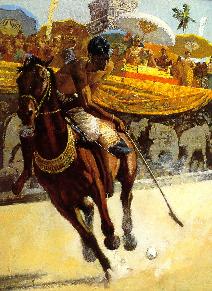 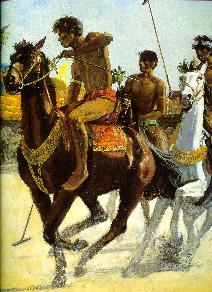
Polo
players played under the eye of King Jayavarman VII, seated beneath a parasol on
the royal Elephant Terrace at Angkor Thom. The popular sport, also depicted in relief, sometimes matched commoners against noblemen, according to
accounts.
(image
source: Splendors
of the Past: Lost Cities of the Ancient World - National
Geographic Society. p. 210)
***
 The art of Kambuja is of Indian origin.
The most famous example of the Kamboja art is the Angkor
Vat which was built by King
Suryavarman II. It is a massive structure
surrounded by a canal tow and half miles long and 650 feet broad. Three
concentric squares form decreasing terraces, elevated one above another with
long galleries of of repeated columns crowned by the final towers, which soar up
in the sky in one splendid sweep of graceful symmetry. The art of Kambuja is of Indian origin.
The most famous example of the Kamboja art is the Angkor
Vat which was built by King
Suryavarman II. It is a massive structure
surrounded by a canal tow and half miles long and 650 feet broad. Three
concentric squares form decreasing terraces, elevated one above another with
long galleries of of repeated columns crowned by the final towers, which soar up
in the sky in one splendid sweep of graceful symmetry.
The choice of Angkor as the site of
the Khmer capital stemmed from several factors. First, it was near the
geographical center of the kingdom. Second, the Tonle Sap, the great lake with
its outlet to the riverine network of the Mekong, provided excellent
communications with the outside world. Finally, there was the great lake itself.
"The grand lake, is a very rare geographical
phenomenon." In the summer, when you have the melting of snow in
Tibet and the beginning of the monsoon rains, the Mekong carries so much water
that some of it backs up into the Tonle Sap, which expands to ten times its
normal area. By November or December, the Mekong slows down and the water again
flows out of the lake. Every year this brings fresh deposits of fertile soil to
the lands along the shore. It is the best possible land for growing rice.
The capital became famous in Asia and was
known as 'Angkor the Magnificent,' a city of a million inhabitants, larger and
more splendid than the Rome of the Ceasers. Near the city stood the vast temple
of Angkor Vat. The empire of Khamboja flourished till the end of the 13th
century and accounts of a Chinese envoy who visited it in 1297 describes the
wealth and splendor of its capital.
Amaury de
Riencourt has written:
Art
flourished in Kamboja as never before, centered around a capital city known to
all Asia as Angkor, the Magnificent, a city of more than a million inhabitants -
which when it was extricated from the jungle in modern times, contained not a
single human being. Chinese and Indian envoys could hardly believe their eyes
when they gazed at the splendid temple of Angkor Vat, a
sublime work of art that was inspired by India but shaped by the
genius of Khmer people."
(source: The
Soul of India - By Amaury de
Riencourt ISBN 0907855032 p. 160-161).
 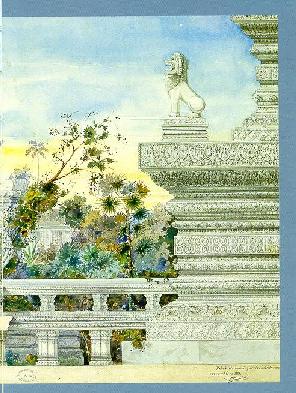
French architect Lucien
Fournereau's paintings of the splendor of Angkor Wat displayed at the Paris
Salon in 1890.
(image source: Angkor:
Heart of an Asian Empire - By Bruno Dagens p.1).
***
About Angkor,
Osbert Sitwell, in his book Escape
with Me - an Oriental Sketch Book (1941),
has written:
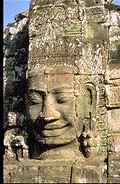 "Let it be said immediately that Angkor, as it stands, ranks as chief wonder of
the world to-day, one of the summits to which human genius has aspired in stone,
infinitely more impressive, lovely and, as well, romantic, than anything that
can be seen in China...The material remains of a civilization that flashed its
wings, of the utmost brilliance, for six centuries, and then perished so utterly
that even his name has died on the lips of man." 'the neighboring Bayon can
be said to be the most imaginative and singular in the world, more lovely than
Angkor Vat, because more unearthly in its conception, a temple from a city in
some other distant planet...imbued with the same elusive beauty that often lives
between the lines of a great poem." "Let it be said immediately that Angkor, as it stands, ranks as chief wonder of
the world to-day, one of the summits to which human genius has aspired in stone,
infinitely more impressive, lovely and, as well, romantic, than anything that
can be seen in China...The material remains of a civilization that flashed its
wings, of the utmost brilliance, for six centuries, and then perished so utterly
that even his name has died on the lips of man." 'the neighboring Bayon can
be said to be the most imaginative and singular in the world, more lovely than
Angkor Vat, because more unearthly in its conception, a temple from a city in
some other distant planet...imbued with the same elusive beauty that often lives
between the lines of a great poem."
Round the great temple of Angkor Vat is a
vast area of mighty ruins with artificial lakes and pools, and canals and
bridges over them, and a great gate dominated by ' a vast sculptured head, a
lovely, smiling but enigmatic Cambodian face, though one raised to the power and
beauty of a god.' The face with its strangely fascinating and disturbing smile -
the 'Angkor smile' is repeated again and again.
(source: The
Discovery of India - By
Jawaharlal Nehru.
p.208-209).
"Its
splendid plan, the balance of its proportions, the elegance of its pillared
cloisters and the beauty of its decoration make it one of the masterpieces of
world architecture."
(source: The
Oriental World
- By Jeannine Auboyer
Landmarks of World's Art quoted from Appendix page).
Helen
Ibbitson Jessup author of Sculpture
of Angkor and Ancient Cambodia: Millennium of Glory captures to
near perfection the overwhelming sensation of awe and
mystery that Angkor – among the greatest, and the most ambitious, of
architectural monuments in the world – produces in the heart of even the most
hardened, or casual, visitor. For
the site, with its sprawling, seemingly endless, expanse and decay does not sum
up the past of Cambodia alone, but, in some ways, of mankind itself.
The
majestic site: miles of ‘gallery and tower’, ancient temples soaring
heavenwards and crumbling at the same time, monuments to man’s faith and
energy, stone and root and dust.
(source: Angkor:
The curling roots of time - tribuneindia.com).
Sacred River Discovered in
Cambodia
Source: Sunday Times, London
Cambodia, Vietnam: In the jungle of Cambodia, at
the site of Phnom Kulen, 20 miles from the temple complex at Angkor Wat, a
priceless devotional work of art, the "River of a Thousand Lingas,"
has been discovered. Carved in the rock of a riverbed, the Siva
Lingas blessed the water flowing over them from the mountain as it irrigated the
rice paddy fields or provided a water source to the ancient
city of Angkor on the plains. Similar river carvings exist in India.
Dating as far back as 802 ce, when the Hindu Khmer
Empire ruled most of Southeast Asia, the Phnom Kulen plateau has multiple
temples with sculptures of elephants and lions six meters high. However, the
Vietnamese war has left its mark on this holy site. The area is infested with
landmines and the Cambodian government, lacking in funds to nurture the temples,
has tendered its development out to a company headed by Seang Nam, the MP for
Siem Reap. A road has been cleared to the Phnom Kulen temples where there are
plans for a hotel. Looters are stealing precious carvings from the site to sell
in Bangkok.

Khmer Monarch pays homage to
Lord Shiva while his personal priest pours offering of melted ghee and
lotus.
(image source: Splendors
of the Past: Lost Cities of the Ancient World - National
Geographic Society. p. 197).
For
more refer to chapters on Ethereal Prambanan
and Sacred
Angkor
and Glimpses
XII to
Glimpses XIX.
***
Ganesha Displayed in
Cambodia's National Museum
http://www.hinduismtoday.com/hpi/2001/5/9.html#3
Phnom Penh, Cambodia, May 9, 2001: Phnom Penh's
National Museum of Art, forgotten for many years, is once again showing the
world its true colors. The extraordinary collection of bronze and stone statues
on display here is unmatched elsewhere in the world. Tragically, looting and war
have removed most of the decorative statues and reliefs from Angkor's temples,
making the museum's collection all the more important as evidence of the
artistic achievements of this ancient culture. The first temporary exhibition in
the museum's history took place last year, with a
display of statues of Ganesh, the elephant-headed Hindu god. Other gems include
the 7th-century statue of the horse-headed Vaijmukha and a delightful tiny
11th-12th century bronze figure of a dancing woman on a lotus flower.
Beauty is only part of it. For these are sacred objects, and the museum has
taken care to position them much as they would have been placed in temples.
Indeed, many of the Cambodians who come to the museum are not simply admiring
art works -- they are paying homage to holy icons and small shrines have been
set up where offerings of flowers can be made.
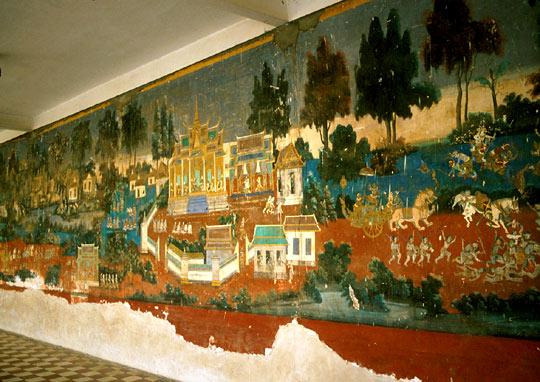
The
walls surrounding the compound – the oldest part of The Royal Palace – are
covered with frescos depicting episodes from the Khmer version of Ramayana,
the Reamker.
***
Cambodia's national
flag, which features the imposing facade of
Angkor Wat, the 12th century Hindu temple dedicated to Lord
Vishnu, is only one of the symbols of how deeply internalized India
is in the collective consciousness of the Cambodian people.
(source:
Cambodia
embraces India's pride - By
Shobori Ganguli - dailypioneer.com 4//11/02).
It is a pity India has
forgotten the Angkors.
A visit to Siem Reap is essential to
understand Hinduism and to appreciate Indian art. There is a visible happiness
in the deities that is rare in the more withdrawn imagery of India. The temples
are mysterious and haunting as they brood over the dark jungle, guarding secrets
of an ancient people lost in time.
(source:
The
temples of Angkor - By Nanditha Krishna - newindpress.com). Refer
to India
once ruled the Americas! – By Gene D Matlock
Top
of Page
Philippines
aka Panyupayana
Philippines was for a time part of the Sri
Vijaya Empire, which has been described by Filippino historians, as Hinduistic
in culture.
Dr
Pardo de Tavera has observed:
“It is impossible to believe
that the Hindus, if they came only as merchants, however great their number,
would have impressed themselves in such a way as to give to these islanders, the
Philippines, the number and the kind of words, which they did give. These names
of dignitaries, of caciques, of high functionaries of the court, of noble
ladies, indicate that these high positions, with names of Sanskrit origin, were
occupied at one time by men, who spoke that language. The words of similar
origin, for objects of war, fortresses and battle songs, for designating objects
of religious beliefs, for superstitions, emotions, feelings, industrial and
farming activities, show us clearly that the warfare, religion, literature,
industry and agriculture were at once time in the hands of the Hindus and that
this race was effectively dominant in the Philippines.”
(source: El
Sanscrito en la langua Tagalag - T
H Pardo de Tavera Paris 1887; The
Philippines and India - Dhirendra Nath Roy Manila 1929 and India
and The World - By Buddha Prakash p. 119-120).
According to Alfred Louis Kroeber
(1876-1960), American anthropologist, and a major
figure in the founding of modern anthropology, as well as author of Peoples of the
Philippines (1919):
"Most of the folklore of the
Philippines is of Hindu origin."
"There is no tribe
in the Philippines no matter how primitive and remote, in whose culture today
elements of Indian origin cannot be traced." Pre-Spanish Philippine society
with its nobility, code of laws, and political procedure, was largely of Indian
cast. Some years ago when a legislative building was put in Manila, the capital,
four figures were carved on its facade illustrating the source of the Philippine
culture, one of which is Manu, the ancient Indian lawgiver. Beyer,
the first to conduct systematic archaeological investigation in the Philippines,
finds formidable evidence to strengthen the view that there was pre-Christian
contact between India and Southeast Asia.
 The Hindu element in the ancient
Philippine religious beliefs, and in the names of old Philippine gods, and of
legendary heroes is quite apparent. Several religious objects have been
unearthed in the island of Mactan, including two images of Hindu deities. The Hindu element in the ancient
Philippine religious beliefs, and in the names of old Philippine gods, and of
legendary heroes is quite apparent. Several religious objects have been
unearthed in the island of Mactan, including two images of Hindu deities.
Two Filipino scholars, Tavera and
Paterno,
have concluded that about 25 % of the Philippine vocabularies can be traced to
Indian influence.
For instance: bahagi (part, portion), in
Tagalog is bhag in Hindi,
katha (story, fiction) - katha;
diwata (god or goddess) is devata
dukha (poor, destitute) is duhkha
guru (teacher) is guru
mukha (face) is mukha
yaya (nurse) is aya and so on..
Philippine literature, stories, and
folklore are traceable to India. The Maranawa epic -
An adaptation of "The Ramayana,"
the 4th century Indian epic, as preserved by the Maranao people of the South
Philippines. A story of the battle between good and evil, with love, deceit,
heroism and triumph
http://www.tabacofamily.com/jtabaco/india.asp
 "Rajah Mangandiri" or "the Ramayana of the
Philippines. Certain parts of southeast Asia, including the southern
Philippines, Malaysia, Thailand and Indonesia, were dominated by the Hindu
culture of the Sri Vidyayah Empire from the 4th to the 10th centuries, said a
press release. Some aspects of Hindu culture, for instance the Ramayana and the
Mahabharata, have thrived in those regions to the present day. "Rajah Mangandiri" or "the Ramayana of the
Philippines. Certain parts of southeast Asia, including the southern
Philippines, Malaysia, Thailand and Indonesia, were dominated by the Hindu
culture of the Sri Vidyayah Empire from the 4th to the 10th centuries, said a
press release. Some aspects of Hindu culture, for instance the Ramayana and the
Mahabharata, have thrived in those regions to the present day.
http://www.indiaabroadonline.com/PublicAccess/ia-12082000/Arts/Philippine.html
The history of Malacca is largely the
story of the city for which it is named, and the story of the city of Malacca
begins with the fascinating and partly legendary tale of the Hindu prince
Parameswara.
An eminent historian of the
Philippines suggests ethnic affinity between Indians and Filipinos, because of
which certain racial qualities of the Filipinos - their dignity of bearing,
their stoical outlook on life, and their indifference to pain and misfortune -
were inherited from the Hindus.
(source: Philippine
Political and Cultural History - By G. F. Zaide p. 45).
When the Philippines drafted its
Constitution, it placed the statue of Manu in the Assembly Hall with this
inscription on its base: "The first, the greatest and the wisest law-giver
of mankind." Researches into the racial and cultural origins of the
Philippines increasingly prove that it was colonized by some people in South
India. In fact, the script of the Filipinos has some obvious similarities with
that of South India. "Our dialects belong to the Dravidian family."
says Justice Romualdez. "The names of some places on the shores of Manila
Bay and the coast of Luzon show their Sanskrit origin."
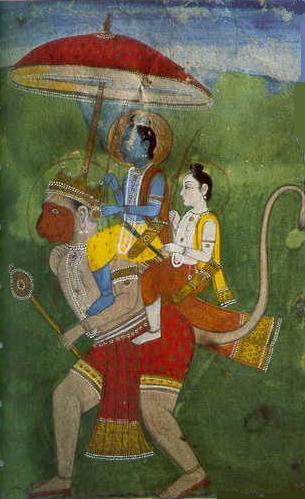
Lord Rama and Laxman being
carried by Hanuman.
***
Indian influence is most patent in
handicrafts and the old names of coins used there. Many social customs current
there show a likeness to the Indian ones. Saleeby says, "The head-gods of
the Indian Triad and the earliest Vedic gods had the foremost place in the minds
and devotion of the hill-tribes of Luzon and Mindanao. A Ganesha statue too was
found there.
Indeed as Beyer says, "India has most profoundly affected the
Philippine civilization."
Even the national flower
of Philippines is the Indian champaka. The Indian influence on
Philippines is explicable by the fact that it was that it was for 150 years a
colony of a Java-based Hindu Empire of Sri Vijaya.
(source: The
Soul of India - By Satyavrata R Patel p. 30).
For more information on Philippines
refer to chapter on Glimpses
XV.
Top
of Page
Japan
 Hajime
Nakamura (1912 - 1999) Japanese scholar. His
field of research was exceedingly broad, encompassing Indian philosophy,
Buddhist studies, historical studies, Japanese thought, comparative thought. He
was the author of The History of Early Vedānta
Philosophy an epoch-making study in four volumes. Hajime
Nakamura (1912 - 1999) Japanese scholar. His
field of research was exceedingly broad, encompassing Indian philosophy,
Buddhist studies, historical studies, Japanese thought, comparative thought. He
was the author of The History of Early Vedānta
Philosophy an epoch-making study in four volumes.
"India is
culturally, Mother of Japan. For centuries it has, in her own characteristic
way, been exercising her influence on the thought and culture of Japan."
"The study
of Japanese thought is the study of Indian thought." - Eminent
Zen Scholar, Dr. D.
Suzuki.
(source: India:
Mother Of Us All - By Chaman Lal p. 25).
Sir Charles
Elliot
(1862-1931) British diplomat and colonial administrator, in his book, Hinduism and Buddhism,
vol. I, p 405 wrote:
"Zen
is the Japanese equivalent of Sanskrit Dhyana (meditation) or Ch'an
and is the name given to the sect founded in China by Bodhidharma.
For more refer to chapter on Glimpses
XVII.
***
Hinduism and Buddhism went from India to
China and Korea to Japan. Those Indian ideas which found their way to Japan were
transmitted through China or Central Asia, although there had been some direct
contact between India and Japan by sea. According to a scholar of ethnology,
there is evidence of the presence of an Indian community in the Shima district
in Mie prefecture. These Indians were called Tenjiku
Ronin, meaning the "masterless Indian
samurai."
Images of Ganesha and Vishnu have been found
throughout Japan. Numerous Buddhist deities were introduced into Japan and many
of these are still very popular.
 According to
D. P.
Singhal, "some
Hindu gods, who had been incorporated into the Buddhist pantheon, were amongst
them. For example, Indra,
originally, the god of thunder but now also the king of gods, is popular in
Japan as Taishaku
(literally the great King Sakra). According to
D. P.
Singhal, "some
Hindu gods, who had been incorporated into the Buddhist pantheon, were amongst
them. For example, Indra,
originally, the god of thunder but now also the king of gods, is popular in
Japan as Taishaku
(literally the great King Sakra).
(source: India
and World Civilization - By D. P. Singhal Part II p.
80-98).
Ganesha
is worshipped as Sho-ten
or Shoden (literally, holy god)
in many Buddhist temples, and is believed to confer happiness upon his devotees.
There
are some rare Ganesha bronzes as Vinayaka in Japan. A sea-serpent worshipped by sailors is called Ryujin, a Chinese equivalent of
the Indian naga. Hariti and Dakini
are also worshipped, the former as Kishimo-jin, and the latter by her original
name. Bishamon is a Japanese equivalent of the Indian Vaisravana (Kubera),
the god of wealth. Sakira s an old name of Indra
by which he is chiefly known in Japan.
Even Shinto adopted Indian gods, despite
its desperate efforts after the Meiji Revolution to disengage itself from
Buddhism. The Indian sea god Varuna,
is worshipped in Tokyo as Sui-ten (water-god); the Indian goddess of learning, Saraswati,
has become Benten (literally, goddess of speech), with many shrines dedicated to
her along sea coasts and beside lakes and ponds.
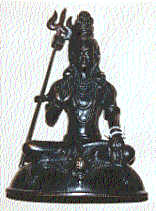 Shiva
is well known to the Japanese as Daikoku (literally, god of darkness), which is
a Chinese and Japanese equivalent of the Indian Mahakala, another name of Shiva.
Daikoku is a popular god in Japan. At the Kotohira shrine on the island of
Shikoku, sailors worship a god called Kompera,
which is a corruption of the
Sanskrit word for crocodile, Kumbhira. The divine architect mentioned in the Rig
Veda, Vishvakarma,
who designed and constructed the world, was regarded in ancient Japan as the god
of carpenters, Bishukatsuma. Shiva
is well known to the Japanese as Daikoku (literally, god of darkness), which is
a Chinese and Japanese equivalent of the Indian Mahakala, another name of Shiva.
Daikoku is a popular god in Japan. At the Kotohira shrine on the island of
Shikoku, sailors worship a god called Kompera,
which is a corruption of the
Sanskrit word for crocodile, Kumbhira. The divine architect mentioned in the Rig
Veda, Vishvakarma,
who designed and constructed the world, was regarded in ancient Japan as the god
of carpenters, Bishukatsuma.
The Indian Yama, the god of death, is the most
dreaded god of Japan, under the name of Emma-o, the king of hell. There is some Indian influence on
Japanese art. A similarity between Shinto
rituals and Hindu rituals - for example ringing the bell as one
enters the temple.
The climbers wearing traditional white
dress, who scale the sacred Mount Ontake as a religious observance, sometimes
have inscribed on their robe Sanskrit Siddham characters of an ancient type.
Sometimes they put on white Japanese scarfs (tenugui) which carry the Sanskrit
character OM, the sacred syllable of the Hindus.
According to author, Terence
Dukes,
"The Gagaku dances of Japan contain many movements
derived from the Indian Nata and the Chinese
Chuan Fa."
(source: The
Boddhisattva Warriors: The Origin, Inner Philosophy, History and Symbolism of
the Buddhist Martial Art Within India and China p.206).
The cultivation of cotton in Japan is
traced to an Indian who had drifted to the shore of Aichi Prefecture in 799. To
commemorate the event, the Japanese named the village where the shipwrecked
Indian had landed Tenjiku; Tenjiku was the Japanese name for India, and means
Heaven.
 The popular Japanese game of
sunoroku or
sugoroku (backgammon played at the royal of the Nara rulers and still popular in
Japan is of Indian origin. In Japan the game is played as nard. Nard is
generally regarded as an Iranian game, but the ninth century Arab scholar, Al Yaqubi, considered nard an Indian invention
used to illustrate man's dependence on chance and destiny. According to Wei-Shu,
sugoroku was brought to China in ancient times from Hu country, which at that
time meant a country somewhere in the vicinity of India. Again, as Karl Himly
has pointed out, the Hun Tsun, Sii, written during the Sung period (960-1279),
states that t'shu-pu, another Chinese name for sugoruku, was invented in western
India, that it was known in its original form as chatushpada,
and that it reached China during the Wei period (220-265). The popular Japanese game of
sunoroku or
sugoroku (backgammon played at the royal of the Nara rulers and still popular in
Japan is of Indian origin. In Japan the game is played as nard. Nard is
generally regarded as an Iranian game, but the ninth century Arab scholar, Al Yaqubi, considered nard an Indian invention
used to illustrate man's dependence on chance and destiny. According to Wei-Shu,
sugoroku was brought to China in ancient times from Hu country, which at that
time meant a country somewhere in the vicinity of India. Again, as Karl Himly
has pointed out, the Hun Tsun, Sii, written during the Sung period (960-1279),
states that t'shu-pu, another Chinese name for sugoruku, was invented in western
India, that it was known in its original form as chatushpada,
and that it reached China during the Wei period (220-265).
Indian legends also found their way into
Japanese literature. An example of this is the legend of Rishyasringa
in which a rishi who had never seen a woman was seduced by Shanta, the daughter
of King Lomapada. This is a very famous story in the Mahabharata.
In the Japanese version the saint is named Ikkaku
Sennin, that is Ekasrnga
(Unicorn). The Kakuki drama, Narukami,
was derived from this legend. Many such Indian stories were incorporated into
Buddhist literature and conveyed to Japan.
Kukai
started the study of Sanskrit letters, known as Shittan,
a Japanese equivalent of the Sanskrit word Siddham, with which
ancient Indian inscriptions and works often begin. Before this, during the Nara
period, the Vinaya; the Abhidharmakosa by Vasubandhu; the Satyasiddhi by
Harivarman; the works of Nagarjuna and Aryadeva; the Vijnaptimatrata, Buddhist
idealism, and the Gandhavyuha sutra had been studied.
In some Japanese
temples, very ancient manuscripts in Sanskrit are preserved intact. It is
significant that many of those manuscripts found in Japan are much older than
those preserved in India.
(source: India
and World Civilization - By D. P. Singhal Part II p.20-27).
According to author Donald A. Mackenzie:
"The Indian form of myth of the Churning of the
Milky Ocean reached Japan. In a Japanese illustration of it the
mountain rests on a tortoise, and the supreme god sits on the summit, grasping
in one of his hands a water vase. The Japanese Shinto myth of creation, as
related in the Ko-ji-ki and Nihon-gi,
is likewise a churning myth. Twin deities, Izanagi, the god, and Izanami, the
goddess, sand on "the floating bridge of heaven" and thrust into the
ocean beneath the "Jewel Spear of Heaven". With this pestle they churn
the primeval waters until they curdle and form land."
(source: Myths
of Pre-Columbian America - By Donald A. Mackenzie
p.190-191).
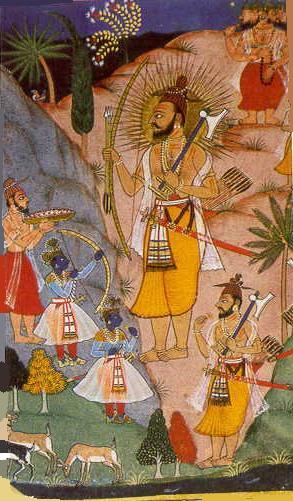
Parashuram with the axe.
Refer
to India
once ruled the Americas! – By Gene D Matlock
***
Japan
's Hindu linkages still alive
One
can also see the influence of the Indian
epic Ramayana
in the traditional Japanese dance forms of 'Bugaku'
and 'Gigaku'
Apart
from the widely known fact that Buddhism in
Japan
has its origin in
India
, not many probably know that so many Hindu deities surround the life of a
Japanese. Speaking
at a lecture titled 'Hindu Gods and Goddesses rooted to
Japan
' here Friday, Lokesh
Chandra, the director of International Academy of Indian Culture, highlighted how deeply Indian religion and
culture has influenced Japanese culture and tradition over the past centuries.
He said that many temples across
Japan
are full of Hindu deities.

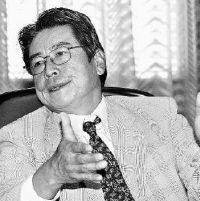
Lokesh
Chandra, the director of International Academy of Indian Culture and Japanese
Ambassador to India Yasukuni Enoki.
For more refer
to chapter on Glimpses XVII.
***
Chandra said Japanese couples who desire to have a
beautiful daughter pray to goddess 'Saraswati' even to this day.
Saraswati is also believed as the patroness of writers and
painters. 'In ancient times, Japanese generals prayed to
Saraswati to be victorious in war,' Chandra told the gathering which was also
attended by the Japanese
Ambassador to India Yasukuni
Enoki and his wife. Year 2007 is being celebrated as Japan-India
Friendship Year to commemorate the 50th year of the cultural agreement between
the two countries.

Benzaiten
or Saraswati in Japan.
***
According
to Chandra, who has travelled to
Japan
many times to study the country's culture and tradition, Saraswati is also
worshipped as the 'goddesses of kitchen'. Many traditional Japanese plays are
dedicated to the Indian deity. Sharing a trivia he said how in 1934, a Japanese
woman had a vision that she was the incarnation of goddess Saraswati and stared
writing in Sanskrit, a language she never heard off.
There
is a suburban district in
Tokyo
named Kichijo, which
traces its roots to 'Lakshmi',
the Hindu goddess of wealth. Lakshmi
was propagated to
China
along with Buddhism in the ancient time, to be known as Kichijo in its Chinese
form and then reached
Japan
as a Buddhist goddess.
Chandra
also spoke extensively about how Sanskrit language has influenced traditional
Japanese calligraphy.
The Indian text was introduced into Japanese
society many centuries ago. Japanese monks had to study Sanskrit in order to
master Buddhism from original Indian scriptures and textbooks. Lord
Ganesha in
Japan
symbolises the joy of life that arises from the power rooted in the virtues of
wisdom and compassion. Young Japanese worship Ganesha to win in love
whereas the old worship the deity to get success in business. There
are roughly 100 temples dedicated to Ganesha in
Japan
.
An
11th century Ganesha temple is the oldest among them.
Together with Hindu gods and goddess, ancient
Japanese society was also introduced to Indian dance forms and musical
instruments. A typical example is the '
Biwa
',which actually had its origin from the Indian 'Veena'. One of
Japan
's largest lake is also known as
Lake
Biwa
. One can also see the influence of the Indian epic
Ramayana in the traditional Japanese dance forms of 'Bugaku' and 'Gigaku'. The
yearlong cultural celebration was kicked off here last week that was attended by
former Japanese prime minister Yoshiro Mori among others.
(source:
Japan
's
Hindu linkages still alive
- rxpgnews.com).
For more refer to chapter on Glimpses
XVII.
***
Indian
Influence on Japanese Stories
A
considerable portion of the cosmogonical and mythological literature of Japan
bears traces of Indian influence. Hajime Nakamura observed ‘ Some stories of
ancient India were very influential in shaping Japanese stories by providing
them with materials. In the process of shaping, however, Indian materials were
greatly modified and adapted in such a way as would appeal to the mentality of
common people of Japan in general’ quoted from Lokesh
Chandra and others – India’s
Contribution to World Thought and Culture.
Post
Wheeler also said ‘Many fragments of the Japanese myth-mass were
unmistakably Indian. The original homeland of the first man and women of
Japanese mythology is said to have been in the Earth-Residence-Pillar i.e. Mount
Meru of Indian mythology. There is another story of Buro-no-Kami whose identity
has been established with the deity called Brave-Swift-Impetuous-male. This Kami
may be none other than the Indian deity Gavagriva, the Ox-head deity. The story
recounts in the style of the jatakas how the deity punished the heartless rich
brother and rewarded the king hearted poor brother. In India one of the names of
the moon is Sasanka (lit. having a rabbit in the lap) and there is an ancient
Indian legend why it is so called. The belief prevalent in ancient Japan that
there lived a rabbit in the moon was probably an outcome of the Indian
influence.
The
story of the monkey and the crocodile mentioned in the Jataka appears in a
slightly modified form in Sasekishu, a medieval Japanese collection of popular
stories. The story is referred to in a work by Nichiren 1222-82 a.d. and also in
Konjaku-monogatari. Another Puranic story of the sage Rsyarnga is likely to have
reach Japan in the trail of Buddhist legends. A famous medieval Japanese drama
Narukami has been based on this story.
These
instances clearly illustrate the nature and extent of Indian influences on
Japanese stories.
Japanese
literature is also replete with instances of the influence of the Indian Theory
of Karma and the transmigration of the soul. Although Buddhist
deities like Buddha, Maitreya, Amitabha and Vairocana predominate Japanese
literature; Hindu gods are also quite well known.
|
God
|
Indian Name
|
Japanese
Name
|
|
1.
Seagod
|
Varuna
|
Suiten
|
|
2.
King of Gods
|
Indira
|
Taishakuten
|
|
3.
God of Success
|
Ganesha
|
Shoten
|
|
4.
God of Wealth
|
Kuvera
|
Bishamon
|
|
5.
Goddess of Learning
|
Sarasvati
|
Benten
|
|
6.
Goddess of Fortune
|
Laksmi
|
Kichijoten
|
|
7.
Mahesh
|
Shiva
|
Daikoku
|
|
8.
Divine Architect
|
Visvakarman
|
Bishukatsuma
|
In
the annals of the Todaji temple, it has been stated that the worship
of Sarasvati and Laksmi was first introduced in 722 A.D. and
continued down the centuries. In Bessom Zakki (Description of Gods) written in
the 12th century written in the Siddham script, a corrupt Sanskrit
mantra reads: ‘Sarasvatai svaha namo sarasvatyai mahadevyai svaha, namo
bhagavati mahadevi sarasvati sidhyatu mantrapadami svaha’. A description of
Sarasvati occurs in the voluminous text Asabasho by Shocho 1205-82 and the
rituals connected with her worship have been recorded by Ryoson 1279 to 1349 in
Chapter CXLIX of his Byaku-hokku-sho (The White Jewel of Indian Tradition). The
adoption of these Hindu deities into the Buddhist and Shintonist pantheons of
Japan indicate the influence of India on Japanese religions as well as the
syncretic character of the religious systems of Japan.
The
Japanese language like Sanskrit is inflectional. Its rules governing syntax,
morphology, phonology and semantic structure follow a pattern of its own. The
forty-seven letters of the Japanese alphabet are said to have been devised by
the Japanese Buddhist saint Kobo Daishi 774-835, after the Sanskrit alphabet. The
arrangement of the Japanese syllabary based on the Sanskrit system is also
attributed to the influence of Bodshisena in Japan, which, according
to Riri Nakayama, ‘will continue as long as the Japanese language continues to
exist’. It has been pointed out that the old Japanese song ‘Iroha-uta’
which contains all the 47 Japanese letters, is a liberal translation of a
Sanskrit Buddhist hymn in the Mahaparinirvana-Sutra. The Indian script known as
Siddham, called His-t’an in Chinese and Shittan in Japanese gained currency in
Japan for writing Sanskrit from the 8th century. It was introduced by
Kobo who was responsible for bringing Mantrayana Buddhism from China to Japan.
The
survey made above reveals the immense contribution of India to the theology of
Japanese Buddhism as well as to Japanese literature. The present indications are
that the texts utilized were all written in Sanskrit, probably in the Siddham
script, and there was no intrusion of Pali, unlike in the Buddhist countries of
South-East Asia.
Shinto
is a polytheistic religion, venerating a vast pantheon of kami (gods or
spirits) which range from the local deities of mountains or streams to the sun
goddess Amaterasu. Shintoism
(literally,
“the way of the gods”)
has
been designated by some scholars as the Japanese version of Hinduism - says
author Chaman Lal.
(source:
Japan
- esamskriti.com).
Top
of Page
Korea
Hindu
Princess
Went to Korea
Korean
historians believe that Queen Huh was a princess of an ancient kingdom in
Ayodhya.
She went to Korea some
two-thousand years ago and started the Karak dynasty by marrying a local king,
Suro. Today, the historians say, Queen Huh's descendants number more than
six-million, including the South Korean president - Kim Dae Jung.
A
16-year-old princess from Ayuta
(Ayodhya) went to Korea in 48 ce.
A 13th-century Korean text recounts Princess Heo Hwang-ok explaining that her
parents: "dreamt a God came who said, 'I have sent down Suro to be king of
Kaya. Suro is a holy man and is not yet married. So send your daughter to be his
Queen." She sailed from India, taking a stone pagoda (left) to what is now
Kimhae city.
South Korea's 72nd generation descendents of King Suro believe they
are related to India's present day Raja Bimlendra Mohan Prasad Mishra, whose
ancestors ruled Ayodhya. (Both families have two fishes as their insignia.) They
sent delegations to India to built a monument in Ayodhya to commemorate the
relationship. Though Mishra is unable to trace his ancestry back more than 300
years, he is happy to accept the Koreans' belief and their initiative to invest
$2 billion to make Ayodhya a sister city of Kimhae. "It will lead to the
progress of Ayodhya and I am happy, " he said. "The fact that it is
associated with my family makes it special."
(source:
Korean
memorial to Indian princess
- BBC.com).
South
Koreans may have Indian genes
A genetic discovery in South Korea
has claimed that Koreans could have an Indian ancestor 2000 years ago.
As was reported by
leading South Korean newspaper Joong Ang Daily on Friday, researchers in an
archaeological survey at ancient royal tomb of Gimhae in South Gyeongsang
province, found some evidence to support claims that Koreans have DNA traceable
to South or South East Asian ethnic groups like Indian, Malaysian or Thai.
Dr Seo Jeong-sun of Seoul National University and Kim Jong-il of Hallym
University conducted the research and decoded the entire genetic code of ancient
Korean remains. They have recently presented their findings at a meeting of the
Korea Genome Organisation in Chuncheon, Gangwong province. The
findings have gained interests in the backdrop of the popular romantic legend of
an Indian princess married to a Korean king of the Great Gaya dynasty. According
to the legend, the Korean king from Southeast Korea, Kim Su-ro, married an
Indian princess, Heo Hwang-ok, from the ancient Indian kingdom of Ayodhya.
The stories say that Heo travelled by ship to Korea. The Great Gaya dynasty
ruled Southeast Korea till 562 AD. In fact, Heo is still a common family name in
Korea. The researchers now say that the myth could turn out to be true,
according to the daily. More studies are in the offing. The genetic study at
Gimhae tomb focused on the mitochondrial DNA in the human remains.
(source:
South
Koreans may have Indian genes -economictimes.com).
Top
of Page
Nepal
India's immediate neighbors Nepal and
Tibet, owe much of their cultural inheritance to contact with India. Originally
the word Nepal implied the Valley, which, surrounded by the peaks of the
Himalayas. The holy scriptures of the Hindu
religion like the Vedas, Brahmangranthas and Upanishads are the common heritage
of the Nepalese and Indians.
The Pashupatinath
Temple
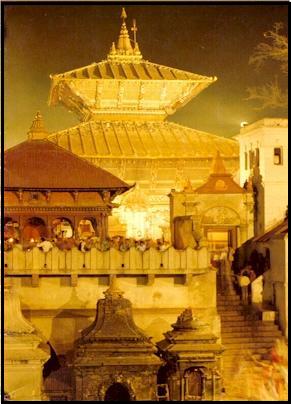 Skanda Puran
the ancient holy text of the Hindu religion, describes the fame of Nepal as -"in
the Himalayas there is a most auspicious blessed place, where Shanker (the giver
of joy) in the form of Pashupatinath resides." Skanda Puran
the ancient holy text of the Hindu religion, describes the fame of Nepal as -"in
the Himalayas there is a most auspicious blessed place, where Shanker (the giver
of joy) in the form of Pashupatinath resides."
All ancient Hindu religious
text has described Himalayas as the abode and activity of Lord Shiva in which
Nepal remained the nucleus. To the west
coast of river Bagmati, which arises from a sprout in the Himalayas, is the
revered seat of Lord Pashupatinath.
It is said that a holy bath in the Bagmati river
at this spot, praying with hymns of 'Rudri Mantra', followed by worshipping
Pashupatinath Lingum with Panchamrita - curd, ghee (purified butter) sugar,
honey and milk, will render the person free from the cycle of births. So is the
magnanimity of Lord Pashupatinath in the minds of Hindus the world over.
The rulers of Nepal, over centuries
made contributions in enriching and beautifying this holy temple.
According to Gopalraj Vamsavali, the oldest ever chronicle in Nepal, this temple
was built by Supus Padeva, a Linchchhavi King who according to the stone
inscription erected by Jayadeva 11 in the courtyard of Pashupatinath in 753 AD
happened to be the ruler 39 generation before Manadeva (464-505 AD). Yet,
there is another chronicle which states that this temple was in the form of
Linga shaped Devalaya before Supus Padeva constructed a five storey temple of
Pashupatinath in this place. As the time passed, the need for reparing and
renovating this temple arose. It is learnt that this temple was
reconsturcted by a mediaeval King named Shivadeva (1099-1126 AD). It was
renovated by Ananta Malla adding a roof to it.
(source: http://www.shripashupatinath.org/thelegend.asp).
Lord Gautam Buddha, the light of Asia, who was born
in Lumbini in Nepal, trekked down to the plains in India in search of
Enlightenment.
 It is a proven fact that Valmiki, the composer of renowned epic
the Ramayana, saw the light of the world within Nepal at Balmikinagar in
Bhisalotoan.
It is a proven fact that Valmiki, the composer of renowned epic
the Ramayana, saw the light of the world within Nepal at Balmikinagar in
Bhisalotoan.
Nepal has never known religious conflict and persecutions, and even
today Hinduism and Buddhism live together in complete harmony. Nepalese
sculpture and painting is in a style derived from the Pala art of Bihar and
Bengal. Many of the laws of Nepal and its social organizations naturally reflect
Hindu models, and the Nepalese language is very close to Sanskrit. But the Hindu
civilization in Nepal has evolved a distinct character of its own, effected
through a blending of its own traditions with those of Tibet.
For
more refer to chapter on Glimpses
XII to
Glimpses XV.
Top
of Page
Tibet
It cannot be denied that Tibet has
borrowed its culture and civilization from India. Tibet, whose art is close
to that of Nepal was, in fact, adopted the Pala
tradition of India, through Nepal and Kashmir.
Over the centuries, as Buddhism took hold
throughout Tibet, the artistic traditions of India influenced Tibetan art. India
brought the tradition of painting figures to Tibetan art, while China taught
Tibetan artists to visualize nature.
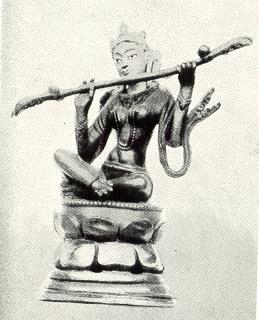
The Goddess Saraswati
(source: Ukhtomskij Collection - History of Fine Art in India & Ceylon - By
Vincent Smith).
***
The
art of Tibetan Lamaism retains strong elements drawn from Hinduism and Buddhism
in India. In architecture, the chorten, or Tibetan stupa was derived from
Indian prototypes. Except for Buddhism in the 7th century, Tibet scarcely
allowed any other foreign cultural influence within her national frontiers. In
fact, Tibet was the last country to embrace Buddhism, which by the 7th century
was thriving in many other lands. According to the Tibetan chronicles, the
talented king Songtsan-Gampo married the daughter of Amsuvarman, daughter of
Nepal's King, and in deference to the new queen's belief which he himself
favored, built a great temple known as Jokhang to house her image of Buddha. He
also compelled the Emperor of China to give him Princess Wen Ch'eng in marriage.
She too was Buddhist and brought to Tibet the famous Buddha image now enshrined
in Jokhang. Once the practice of visiting India had begun, many Tibetan students
went to India to study Buddhism, and Sanskrit texts began to pour into Tibet.
Indian and Chinese scholars visited Tibet and helped to translate and interpret.
It was during this period that the celebrated sandalwood image of Avalokitesvara,
the compassionate Buddha, now worshipped in the palace of the Dalai Lama, was
supposedly brought to Tibet by Indian scholars.
Other Indian influences also found their
way to Tibet. For instance the Tibetan medical system owes to origin to the Ayurvedic
system of India. Tibetan Tantric forms
are almost indistinguishable from Hindu Tantras, and certain Tantric images like
Halahal-avalokitesvara and Nilkant-avalokitesvara are derived from Lord
Shiva.
Top
of Page
Russia
Ancient
Vishnu idol found in Russian town
Moscow:
An ancient statue of Lord
Vishnu has been found during excavation in an old village in
Russia
's Volga region, raising questions about the prevalent view on the origin of
ancient Russia.

Lord
Vishnu statue found in Staraya Maina
village in
Ulyanovsk
region.
***
The statue found in
Staraya (old) Maina village dates back to VII-X century AD. Staraya Maina
village in
Ulyanovsk
region was a highly populated city 1700 years ago, much older than
Kiev, so far believed to be the mother of all Russian cities.
"We may consider it
incredible, but we have ground to assert that Middle-Volga region was the
original
land
of
Ancient Rus.
This is a hypothesis, but a hypothesis, which requires thorough research,"
Reader of Ulyanovsk State University's
archaeology department Alexander Kozhevin
told state-run television Vesti.
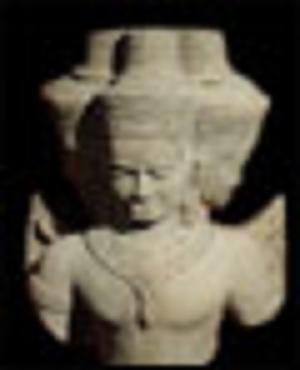
Ancient
statue of Lord Vishnu found in Russia's Volga region. It dates back to 8th
century AD. It raises questions
about the prevalent view on the origin of ancient
Russia
.
***
Kozhevin, who has been
conducting excavation in Staraya Maina for last seven years, said that every
single square metre of the surroundings of the ancient town situated on the
banks of Samara, a tributary of
Volga
, is studded with antiques.
Prior to unearthing of the
Vishnu idol, Dr Kozhevin has already found ancient coins, pendants, rings and
fragments of weapons. He believes that today's Staraya Maina, a town of eight
thousand, was ten times more populated in the ancient times. It is from here
that people started moving to the Don and Dneiper rivers around the time ancient
Russy built the city of
Kiev, now the capital of
Ukraine.
An international
conference is being organised later this year to study the legacy of the ancient
village, which can radically change the history of ancient Russia.
(source: Ancient
Vishnu idol found in Russian town
- Press
Trust of India).
***
 Lake Baikal, which is in Siberia, was known to Hindus as lake Vaikhanas; there
was a group of rishis known as vaikhanas, who meditated on the shores of the
lake. Vaikhanas means deep and powerful thought.
Lake Baikal, which is in Siberia, was known to Hindus as lake Vaikhanas; there
was a group of rishis known as vaikhanas, who meditated on the shores of the
lake. Vaikhanas means deep and powerful thought.
"The pre-Buddhist cult of the
Siberian Buryats was Shamanism where elements of nature and topographic
edifications were freely fused with Shaman songs extolling Indra, Agni and other
Indian deities. These
fascinating songs were prevalent only half a century ago. Now they ar e known
from Prof. Zmacarano's collections done in the early part of this century."
"By the end of the 17th century, Buddhism was firmly entrenched among the
Siberian Buryats."
"In the 1740's Jinba the son of Aghaldai finished his education at the Ton
Khor Manjushri monastery, returned to his country and there be built a
monastery. Asking for permission to spread the Dharma, he got
the command, 'You enter the temple of the Lord and a pothi or holy book and a
painted scroll.' He did as he was ordered. When the holy book was examined, it
turned out to be sabs-rgyas-mchaghum, and when
the painting was examined, it turned out to be Sridevi (Okin tngri)."
"Special sanctity is attached to the Monastery of the Pandita Khampo Lama
or the Buddhist Patriarch of Siberia. In 1870, a gigantic statue of Maitreya,
measuring 44 cubits was installed at his monastery."
"In 1816 was founded the Aginsky monastery which became the foremost seat
of learning in Siberia. It has surved to this day. The major monasteries were 33
in number and they had 50000 xylographic blocks
for printing 1696 Buddhist texts and woodcut illustrations."
"The Siberian monastic Universities had four faculties: 1. Philosophy, ii.
Tantra, iii. Jyotisha (or Kalachakra), iv. Ayurveda. The texts which were
studied there had been translated from or inspired by Sanskrit. To this day,
some of these books are preserved in the Siberian branch of the Academy of
Sciences of the USSR."
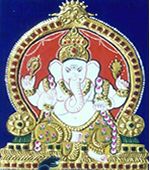 "The monasteries still welcome you with yoghurt mixed with honey and milk,
that is Indian madhuparka. The ashtamangala emblems embellish the walls of
temples. In the library the rare Yisunerdeni-yin Ganjur
in 101 tomes is a collection of Nava-ratna manuscripts written in nine inks
prepared from silver, mumin, coral, turquoise, gold, copper, peals, iron and
conch. It is a pearl of their literature, comprising over a 1000 texts
translated from Sanskrit. Every text opens with Engdkeg-un kele-ber 'in the
language of India, i.e., in Sanskrit.' The writer has brought 14 texts on Ganapati. One of them is Arya-ganapati-stuti, written by the great Siddha
Kanhapada. Another small manuscript on the Mahavinayaka-rupa-upadesa which deals
with the
contemplative form of Vinayaka."
"The monasteries still welcome you with yoghurt mixed with honey and milk,
that is Indian madhuparka. The ashtamangala emblems embellish the walls of
temples. In the library the rare Yisunerdeni-yin Ganjur
in 101 tomes is a collection of Nava-ratna manuscripts written in nine inks
prepared from silver, mumin, coral, turquoise, gold, copper, peals, iron and
conch. It is a pearl of their literature, comprising over a 1000 texts
translated from Sanskrit. Every text opens with Engdkeg-un kele-ber 'in the
language of India, i.e., in Sanskrit.' The writer has brought 14 texts on Ganapati. One of them is Arya-ganapati-stuti, written by the great Siddha
Kanhapada. Another small manuscript on the Mahavinayaka-rupa-upadesa which deals
with the
contemplative form of Vinayaka."
"The Ramayana is also known from Siberian
folklore. The Research Institute of the Siberian Branch of the Academy of
Sciences of the U.S.S.R. has the manuscripts of Prof. Golstunsky's work on a
short version of the Ramayana in the Kalmuk language."
(source: India and
Siberia - By Lokesh Chandra; in Vishveshwaranand Indological Journal,
vol. X11.1-2
March
-September 1974; pg. 192-197).
***
Cultural
Relations of India and Siberia -
By Dr.
Lokesh Chandra
"The
Siberian Patriarch reveres the Holy Water of Ganga Our journey to
Siberia was a mission of friendship, a mission to renew our common ancient
traditions, and to instill a new significance
into them, and above all to carry the Holy Water of the Ganga. For the last few
centuries the Siberian Buryats have not seen the Holy Water. They have
substituted the water of Ganga by the water of Lake Baikal. They say that the
water of Lake Baikal can last up to ten years if kept along with its pebbles and
without them for five years. I have myself brought the water of this `Siberian
Ganga' as we may call it. The Buryats wanted to be blessed again by the Holy
Water of Ganga and that too auspiciously by the sons and daughters of India. One
evening we offered the Holy Ganga Water to the Patriarch with due ceremony. It
was already fast approaching night, it was the hour of non-substantiality. With
the Buryats Dharma is not a ritual but an evocation. It is the finesse of life.
The vessel containing Ganga os, or Ganga-jala, must be commensurate with the
profundity of the object, which it carries. Before receiving the water the
patriarch recited Sanskrit mantras, visibly moved. It was a historic moment in
his life. The Patriarch went on reciting Sanskrit mantras while Ganga-jala was
being poured form the Indian to the Buryat vessel. When some drops fell into the
tray I was wondering as to what would he do with them. He paid due homage to the
fallen drops and poured and them into his vessel. Such is the reverence for the
water of Ganga in those remote parts of the inhabited world. There is hardly a
country in Asia which does not revere Ganga. If the Holy Water is not available,
then the water of indigenous rivers is converted into Ganga Water by special
sadhanas. It is a special genre of worship in Asian countries. Likewise the
Siberian Buryats convert their water of Baikal into Ganga water by specific
offerings and Mantras."
Meghaduta
in Siberia
"I met a gentlemen who was interested in the history of Buryat literature.
He told me that the first lyric in his language is the `Meghaduta', which was
translated from Sanskrit. They have folk poetry, which is earlier, but the `Meghaduta'
forms their earliest written kavya. They have also a translation of the Kavyadarsha. They have not
only this translation, but also commentaries on it citing instances from their
own language, because the translation of the kavyadarsha illustrates only from
Sanskrit, whose assonances, alliteration and the like are lost in translation.
So how can they sense the flow and subtle nuances of poetry in its translated
form? The alternative left is to cite example from their own literature. That is
what they have done in their autochthonous commentaries. Now they are trying to
understand the kavyadarsha. I have sent them many Sanskrit editions with English
translations."
Siberians
eager to study Sanskrit
According to official reports there are half a million people who adhere to
their age-long faith, which is a mixture of Buddhism,
Tantrism and Shaivism and other `ways' (yana) that has traveled there from this
country. It is a syncretic faith, wherein India is
the Holy Land, Sanskrit the divine language, mantras are recited in Sanskrit,
and every child has a certain `samskara'. These half-a-million people look towards India for academic and cultural relations. They are
keen to start Sanskrit studies in their colleges. Some even want to study
technical texts like the Ashtanga-hridaya of Vagbhata in Ayurveda, which was
translated in their language centuries ago.
Ayurveda
in Siberia
 Ayurveda is a living element
of Buryat life. They term it `national medicine'. From Siberia this national
medicine (Ayurveda) travelled to European Russia. During the early part of the
century, at Leningrad there was a famour Siberian doctor, Badmayef by name. His Ayurveda is a living element
of Buryat life. They term it `national medicine'. From Siberia this national
medicine (Ayurveda) travelled to European Russia. During the early part of the
century, at Leningrad there was a famour Siberian doctor, Badmayef by name. His
name is Sanskrit Padma with the Russian suffix-yef. He had also been summoned to
treat Stalin. During the purges he was liquidated and Ayurveda went into
oblivion. For the last few years researches on Siberian Ayurveda have been going
on. I have brought two xylographs from Siberia about their medicinal system.
They illustrate every herb, mineral and animal mentioned in Vagbhata's
Ashtanga-hridaya. It is the first time in the history of Ayurveda that complete
materia medica has been illustrated. Its tradition goes back to the seventh
century. The illustration of anatomical details and surgical instruments
referred to by Sushruta are unique.
To
Siberia, India is the embodied Divine
Freezing Siberia is a land where monasteries had the academic traditions
of Nalanda, where Sanskrit names are still prevalent,
where the Holy Water of Ganga is deeply revered, where mantras ring forth
in the immensities of space and silence, where you may witness the
madhuparka offered with wooden spoons in the true traditions of the
shruti, where purnima and amavasya are holy days with `white food',
where Mahakala pervades the primaeval vastnesses, where stotras to
Goddess Tara are hummed amidst the clanging and sonorous instruments,
where Panini is the model for their linguistic development, where
Meghaduta is their first lyric, where Ayurveda is revealed in the
fullness of its tradition, where an entire literature inspired by
India is preserved, where blessings are given on the triple planes
of kaya, vak and citta, where the saffron is the color of sanctity,
where mantras are still written in the
ornamental Indian script termed Ranjana, where pure gold illumines large
scroll paintings, where people wonder at the size of India's
lotuses on which their Gods and Goddesses sit or stand, and so on.
(source: Cultural
Relations of India and Siberia - Dr. Lokesh Chandra -
Dialogue
October - December, 2001 , Volume 3 No. 2).
***
Sir,
- It augurs well for strengthening the bond between India and Russia when so
many political leaders have openly acknowledged the importance of the age-old
relationship between India and Russia, during the recent visit of the Russian
President, Mr. Vladimir Putin (The Hindu, Oct. 5).
While
Mr. Vajpayee has drawn our attention to the correspondence between Mahatma
Gandhi and the Russian novelist, Leo Tolstoy (1828-1910), I would like to go
back much earlier even to the Puranic age when India had established cultural
contacts with that part of the globe which is at present called Russia.
 It
appears that a few years ago a Russian orientalist
by name Prof. Ribakov from Moscow went to
Kanchi to have the darshan and receive the blessings of the late Kanchi
Paramacharya. The Paramacharya asked the Russian
professor: ``Does not the northernmost part of Russia have more Sanskrit content
in the language?'' The professor was stunned. This scholar, who came to ask
questions, shed tears of joy at the very sight of the Paramacharya and was
dumbfounded at the depth of his scholarship. The Paramacharya further
explained to the Russian that Russia was called `Rishi Varsha' in ancient Indian
geography, because it was the land where our Rishis like sage Yagnavalkya had
their conference on the Vedas. This could further be corroborated by the fact
that some women in the northernmost point of Russia have names like Lopamudrova,
which is stunningly close to Lopamudra, wife of sage Agastya. It
appears that a few years ago a Russian orientalist
by name Prof. Ribakov from Moscow went to
Kanchi to have the darshan and receive the blessings of the late Kanchi
Paramacharya. The Paramacharya asked the Russian
professor: ``Does not the northernmost part of Russia have more Sanskrit content
in the language?'' The professor was stunned. This scholar, who came to ask
questions, shed tears of joy at the very sight of the Paramacharya and was
dumbfounded at the depth of his scholarship. The Paramacharya further
explained to the Russian that Russia was called `Rishi Varsha' in ancient Indian
geography, because it was the land where our Rishis like sage Yagnavalkya had
their conference on the Vedas. This could further be corroborated by the fact
that some women in the northernmost point of Russia have names like Lopamudrova,
which is stunningly close to Lopamudra, wife of sage Agastya.
It
may be recalled that during the Sankalpa (a solemn vow to perform an observance)
at the time of Pooja, we frequently use the term Jambu Dweepa. This term
actually means the entire region covering Asia and Europe, as is evidenced from
descriptions in Puranic geography. Even today I understand that in the USSR
while writing the postal address, the name of the country is written first and
then followed by such specifications as the city, town, area, street number,
etc., in that sequence. This is an ancient Hindu tradition which we follow even
today during our daily Sankalpa in Pujas.
B.
M. N. Murthy, Bangalore
***
Latvia
- In 1862 itself, Latvian intellectuals, litterateurs and academics had arrived
at the conclusion, based on the findings of German linguists, that the ancient
Sanskrit language was, in all respects, nearer to Latvian and Lithuanian than to
any other foreign language. Besides
this, Latvian researchers identified similarities between pre-Christian Latvian
mythology, religious traditions, folklore and Indian mythology and the Hindu
pantheon of gods.
(source: Prof.
Ivbulis: Ardent
Indologist & Tagore Scholar
Tour India
February 2001)
For
more refer to chapter on Glimpses
XII to
Glimpses XV.
Top
of Page
Conclusion
 According to D.
P.
Singhal, " Whatever be the precise nature
of the process of Indian cultural alliance and influence, its extent was deep
and extensive, and it effects were felt in all aspects of culture from religious
thought to the technical skills in agriculture and handicrafts. First, the
Indian alphabetic system, which is still used in Burma, Siam, Cambodia, and
Laos, was introduced, followed by the introduction of Sanskrit and Sanskrit
literature," playing just the same part as Latin in Mediaeval Europe. India
also taught her political system centered on the king, and her main religious
beliefs. Her sacred texts, and her great epics, were so well learnt throughout
this India beyond the seas that they became naturalized in each of these lands.
Finally, India unfolded the secrets of her mathematics and astronomy, making
possible calendar calculations of much greater accuracy than in the past, and
all her technical skill in husbandry and handicrafts." According to D.
P.
Singhal, " Whatever be the precise nature
of the process of Indian cultural alliance and influence, its extent was deep
and extensive, and it effects were felt in all aspects of culture from religious
thought to the technical skills in agriculture and handicrafts. First, the
Indian alphabetic system, which is still used in Burma, Siam, Cambodia, and
Laos, was introduced, followed by the introduction of Sanskrit and Sanskrit
literature," playing just the same part as Latin in Mediaeval Europe. India
also taught her political system centered on the king, and her main religious
beliefs. Her sacred texts, and her great epics, were so well learnt throughout
this India beyond the seas that they became naturalized in each of these lands.
Finally, India unfolded the secrets of her mathematics and astronomy, making
possible calendar calculations of much greater accuracy than in the past, and
all her technical skill in husbandry and handicrafts."
(source: India and World Civilization - By D. P. Singhal).
George
Coedes (1886 -1969) author of Ancient
Hinduized states of the Far East, has pointed out the enduring value
of Hindu culture in Outer or Greater India:
"One is struck by the
fundamental difference in the results achieved in the countries of the Far East,
by the civilizing action of China and that of India. The reason of it lies in
the radical difference in the methods of colonization, employed by the Chinese
and by the Hindus. The Chinese proceeded with conquest and by annexation: the
armies occupied the lands and the officials spread the Chinese civilization. The
Hindu penetration and infiltration seem to have almost always been peaceful and
unaccompanied by those destructions, which disgrace the Mongol cavalcade or the
Spanish conquest of America. Far from being destroyed by the
conquerors, the indigenous people have found in the Hindu society, transplanted
and made supple, a frame, in which their own societies have been able to
integrate and develop themselves." "The
exchange of ambassadors between the two shores of the Bay of Bengal was done on
a footing of equality, whereas China always required of the
" barbarians of the
south" the recognition of her suzerainty, which was expressed by the
regular payment of tribute."
"The lands, militarily
conquered by China, had to adopt or imitate her institutions, customs,
religions, language and script. On the contrary, those, whom India
peacefully conquered, by the prestige of her culture, have preserved
the essence of their individual characters and have developed them, each
according to its own genius."
(source: Les
états Hindouisés d'Indochine et d'Indonésie - By George Coedes p.
64-66).
Thus at a time, when Europe was still
uncivilized, Indian culture, was highly civilized and had made its mark from
Siberia to Cambodia, Java and Vietnam and beyond.
Swami
B. V. Tripurari Americna born,
has eloquently stated:
"The subtlety of Indian society, marks its superiority to Europe. It was a
subtlety of spiritual outlook that Europeans failed to appreciate. The theory
that India, Mother India, is the earthly source of spirituality can be to some
extent supported by the fact that India is still today the most religious
country in the world, with a theology that dates back to antiquity. The idea
that she is the source of civilization as well, although supporting evidence is
available, will ultimately require that modern man reevaluate what constitutes
civilization before it gains wider acceptance."
(source: Ancient
Wisdom for Modern Ignorance - Swami B. V. Tripurari p.
37).
(Note:
It is the norm to debunk the
Calcutta
scholars, Ramesh Chandra Majumdar, Suniti Kumar
Chatterji, Kalidas Nag and others, who launched the Greater India
Society in the Twenties. They did so with Rabindranath
Tagore’s blessings, but the inspiration came from the writings of
the famous orientalist, Sylvain Levi.
Then George
Coedes, director of L’Ecole Francaise d’Extreme Orient, wrote his
classic work, The Indianized States of
Southeast Asia
. Yet, such are the distortions of politics that the Greater India
Society pioneers are dismissed as bombastic nationalists impelled only by the
urge to flaunt in the face of their British rulers the boast that enslaved
though they might be, their ancestors were also proud imperialists with their
own quota of Charlemagnes, Bismarcks and Machiavellis.
Southeast
Asia
’s Islamic revival is largely responsible for denying its Indian
past,
though Islam was taken there by Indian mariners, merchants and maulvis.
European colonists are equally to blame.
When a
French company lost a restoration contract for Angkor
Wat, for instance, it spread the canard that Indian cleansing
methods were damaging the temple. “Can Hindus who
gave us our gods ever destroy them?” asked an incredulous Cambodian
when told of the rumour. Given such malign forces, the disconnect between
India
and its cultural umbra is not surprising. Nor the fact, as a Singaporean author
remarked recently, that the
Indian Ocean
is Indian only in name.
 Sardar
Kavalam Madhava Panikkar
(1896-1963) Indian scholar, journalist,
historian from Kerala, administrator, diplomat, Minister in Patiala Bikaner and
Ambassador to China, Egypt and France. Author of several books, including Asia
and Western Dominance,
India Through
the ages and India
and the Indian Ocean. Sardar
Kavalam Madhava Panikkar
(1896-1963) Indian scholar, journalist,
historian from Kerala, administrator, diplomat, Minister in Patiala Bikaner and
Ambassador to China, Egypt and France. Author of several books, including Asia
and Western Dominance,
India Through
the ages and India
and the Indian Ocean.
As
Panikkar wrote in
India
and the Indian Ocean: An Essay on the Influence of Sea Power on Indian History,
India
and
Southeast Asia
constitute a single entity “connected integrally in their political, social
and economic life”. Since it had been proved that “the
power which controls
India
can at all times control the East Indies”, Panikkar
stressed the importance of
India
playing a leading role in the ocean that bears her name.
(source:
Ancient
Indian Logic - By Sunanda Dattaray
- telegraphindia.com).
For interesting article refer to:
http://www.swaveda.com/articles.php?action=show&id=49.
For
more refer to chapter on Glimpses
XII to
Glimpses XV.
Top
of Page
Articles
Ramayana
Tales told differently
By
Nidhi Chaturvedi
http://www.dailypioneer.com/secon2.asp?cat=\fory14&d=Foray
The
most popular epic Ramayana has been retold in various countries adopting the
local flavour.
Dussehra and Diwali, the two greatest Hindu festivals revolve around the epic
Ramayana and are all about Rama, Sita and Ravana.
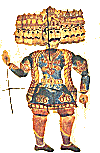 The Ramayana has remained the perennial source of inspiration down the centuries
not only in India but in the whole of South Asia.
Valmiki s Ramayana is the
oldest work of the legend. The Ramayana has remained the perennial source of inspiration down the centuries
not only in India but in the whole of South Asia.
Valmiki s Ramayana is the
oldest work of the legend.
According to a legend, when Narada departed for heaven, Valmiki went to the
banks of Tamasa river, not far from the Jahnavi (ie Ganga). The Ramayana started
its journey from this place.
The different regional versions of the Ramayana like Kambar's Ramayana in Tamil,
Krittivasa's Ramayana in Bengali, Tulsidasa's Ramacharitamanasa in Awadhi,
Eluttaccan's Adyatma Ramayana in Malayalam etc, are not mere translations.
Instead, they also incorporate the local cultures and legends into the adaptions.
The Tibetan story says that Sita was Dasagriva s daughter (ie Ravana) and was
abandoned on the advice of astrologers. She was brought up by the cultivators.
Vishnu incarnated as Rama to kill Ravana. And as the plan, Rama abdicated his
throne and went to the forest to allow Lakshmana to assume kingship.
 In Burma, the legend of Rama goes back to the 10th century. Here, Rama has been
described as a pious Buddhist king. Another Buddhist addition is that Rama and
Sugriva met under the shade of Bodhi tree. In Burma, the legend of Rama goes back to the 10th century. Here, Rama has been
described as a pious Buddhist king. Another Buddhist addition is that Rama and
Sugriva met under the shade of Bodhi tree.
In Malaysia, most of the manuscripts discovered were written after the advent of
Islam. And are thus, subsequently altered in the light of Islamic tenets and
believes. In course of this transformation, many new episodes were included. An
interesting example is that Allah sent Adam to Ravana, and Adam made the latter
the lord of earth, water, nether world and the kingdom of Indra.
King Dasaratha was a great grand son of Adam. He had two wives, Mandudari and
Baliadari. Ravana asked Dasaratha to hand over Mandudari, who in turn assumed an
illusory form named Mandudasi to become Ravana s wife.
According to the Malaya Rama stories, all chief characters such as
Rama, Sita, Ravana, Valin and Hanuman are related to each other. Sita is Ravana s daughter.
Laxman and Hanuman have been have illustrated as great characters.
According to the Thai notion, Valmiki s Ramayana finds its roots in Thailand. In
fact, the Thai identify themselves so much so that they are not interested to
know whether Ramayana was originally written in India.
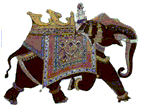 They believe that Ramayana is their own creation and the
Thai Ramakien is the
original Rama story. Many places in Thailand have been identified with Ramayana
episodes. For example, the city of Ayutthaya ie, Ayodhya has been mentioned as
the capital of the kingdom. It is believed that Rama, on his return to Ayodhya
after defeating Ravana, wanted to reward Hanuman for his services. He shot an
arrow and where the arrow fell would be identified as Hanuman s capital. They believe that Ramayana is their own creation and the
Thai Ramakien is the
original Rama story. Many places in Thailand have been identified with Ramayana
episodes. For example, the city of Ayutthaya ie, Ayodhya has been mentioned as
the capital of the kingdom. It is believed that Rama, on his return to Ayodhya
after defeating Ravana, wanted to reward Hanuman for his services. He shot an
arrow and where the arrow fell would be identified as Hanuman s capital.
The arrow fell at the town of Lopburi. The impact of the arrow made the soil
white, that is why the soil of the place is white. There is a hill named
chayanat, with a flattened top. It is believed that when Hanuman went out in
search of certain medicinal plants to save the life of Laxman , he lay on the
top of the hill and swept the nearby forests with his long tail for searching
out the desired plants and herbs. It was then that the top of the hill was
flattened by the body weight of Hanuman. Also included in the epic is a hill
named Sarburi with an indent. Folklore has it that when Ravana, after abducting
Sita, was driving his chariot very fast, the axle of the chariot dashed against
the hill, creating the crater.
The residents of Chonburi attribute the red soil of the place to a bloody fight
between Valin, the monkey king and Thorapi or Dundubhi, a mighty buffalo.
Another striking feature of Ramkien is the character of Hanuman. In India, we
know Hanuman as a celibate (a bramhacharee). But in Ramakien, Hanuman s marriage
has been described in great detail. He had affairs with many women celestial,
demonic and human. He even had children.
There are many interesting deviations in the Lao versions of the Ramayana.
Ravana is a nephew of king Dasrath. Rama, while roaming in the forest in search
of Sita, ate the fruit of a particular tree in the forest and was transformed
into a monkey.
He met a Nengsi, who originally a woman who had been turned into a female
monkey. Rama married Nengsi and Hanuman was born out of this marriage. Rama,
having killed Valin, married the latter's widow.
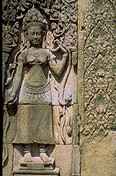 According to
Cambodian Ramaker, Ram was Vishnu s incarnated and
Akaingameso,
doorkeeper of the God, was born as Rava, i.e, Ravana. According to
Cambodian Ramaker, Ram was Vishnu s incarnated and
Akaingameso,
doorkeeper of the God, was born as Rava, i.e, Ravana.
Sita, in her earlier birth, was the wife of Indra, when she was insulted by
Ravana. With a view to avenge the wrong, she was born as Ravana s daughter.
Ravana, as advised by his astrologer brother Bibhek (ie Vibhishana), shut her in
a chest, carried the chest to a distant land and burried it there.
She was later unearthed and discovered by king Janaka. Sugreeva and Valin are
two sons of the wife of a sage, by Aditya and Indra respectively. When the wife
s infidelity was disclosed, the sage cursed the two sons, as a result of which,
they turned into monkeys. Hanuman was born of Svaha (sister of Sugreeva and
Valin) and Naray, ie, Narayana.
The Ramaker, however, closely follows Valmiki s Ramayana episodes of Ram s
friendship with the monkey chiefs, Hanuman s embassy to Lanka, construction of
the bridge, invasion of Lanka by Ram and Laxman, Vibhishana s joining the camp
of Rama, fighting with Indrajit and Kumbhkarna, slaying of Ravana, Sita s ordeal
by fire and Rama s coronation as king.
There is only one difference that Sita gave birth to a son who was named
Ramalaksa by Valmiki. One day, Sita went to the river for a bath with her son
when the sage was engrossed in meditation.
When he did not see the child after his meditation, he created another child by
his yogic power and he was named as Jupalaksa. The rest is as it is in the
Ramayana.
But, the moral of the story is the same in all the versions victory of good over
evil no matter what the deviations.
 
French architect Lucien
Fournereau's paintings of the splendor of Angkor Wat displayed at the Paris
Salon in 1890.
(image source: Angkor:
Heart of an Asian Empire - By Bruno Dagens p. 1).
For
more refer to chapters on Sacred
Angkor
and Glimpses
XII to
Glimpses XIX.
***
Top
of Page
 Did You Know Did You Know
The Color Orange
Orange suffered an identity crisis,
having no name in European languages until orange, the fruit, arrived from Asia.
 The ancestor of the modern orange grew wild in North
India and eventually came by boat to Europe. India has two Sanskrit names for
this fruit, naranga and santara. Naranga became naranj in Arabic, then the
English altered it to orange, Santara got modified to the Portuguese, cintra
hence citrus and related words. The ancestor of the modern orange grew wild in North
India and eventually came by boat to Europe. India has two Sanskrit names for
this fruit, naranga and santara. Naranga became naranj in Arabic, then the
English altered it to orange, Santara got modified to the Portuguese, cintra
hence citrus and related words.
(source: Hinduism Today - December issue
1999 p. 9))
Top
of Page
The Game Connection
 Way
before Columbus sailed the ocean blue in 1492, two almost identical games were
played in India and South America. Hindu pachisi (or parchisi) dates back at
least 2,200 years, and Aztec patolli over 1,600 years. Western Historians
generally refuse to believe there was any contact between Asia/Europe and the
Americas prior to Columbus, and dismiss any evidence to the contrary as
"coincidence" or "independent reinvention." Way
before Columbus sailed the ocean blue in 1492, two almost identical games were
played in India and South America. Hindu pachisi (or parchisi) dates back at
least 2,200 years, and Aztec patolli over 1,600 years. Western Historians
generally refuse to believe there was any contact between Asia/Europe and the
Americas prior to Columbus, and dismiss any evidence to the contrary as
"coincidence" or "independent reinvention."
Parchsi/patolli are among a great deal
of evidence to the contrary. 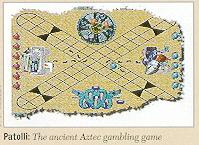
One study calculated the odds against
independent invention of such a complicated game to be 1 in 10 to the
twenty-seventh power- virtually impossible. The rules are basically the same for
these popular gambling games. For example, four people move their four pieces by
casting cowry shells in pachisi, and beans in patolli. When one piece lands on
another person's piece, the other piece goes back to the start.
(source: Hinduism Today
Nov/December 2000 p. 15)
Edward B.
Tylor,
writing in 1881, pointed out that the ancient Mexican game, patolli, a favorite
of the Aztecs, was very similar to pachisi, played in India. ( Anthropology
London: 1881).
(for more information please refer
to chapter on India
on Pacific Waves?).
Top
of Page
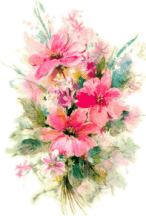 
 
|